
AMBOSELI, KENYA, MAY 2011: Undercover Kenya Wildlife Services Ranger detusk a bull elephant killed by a spear in the Amboseli ecosystem in the shadow of Amboseli, Kenya, May 29, 2011. The elephant was killed by a single spear stroke close to the spine which penetrated deeply enough to cause massive internal bleeding. It is not known whether this was a poaching attempt or whether this was a case of human elephant conflict with the animal in the crops of local Masaai. The animal was detusked and the ivory sent to the KWS HQ in Amboseli National Park. KWS has the mandate to protect wildlife in Kenya but lack the manpower and resources. Organisations like Big Life are the private sector arm of KWS in the 2 million acre Amboseli ecosystem, working alongside them to supply manpower, vehicles, funding, information networks and aircraft to practise effective conservation in the region. (Photo by Brent Stirton/Reportage for National Geographic Magazine.)
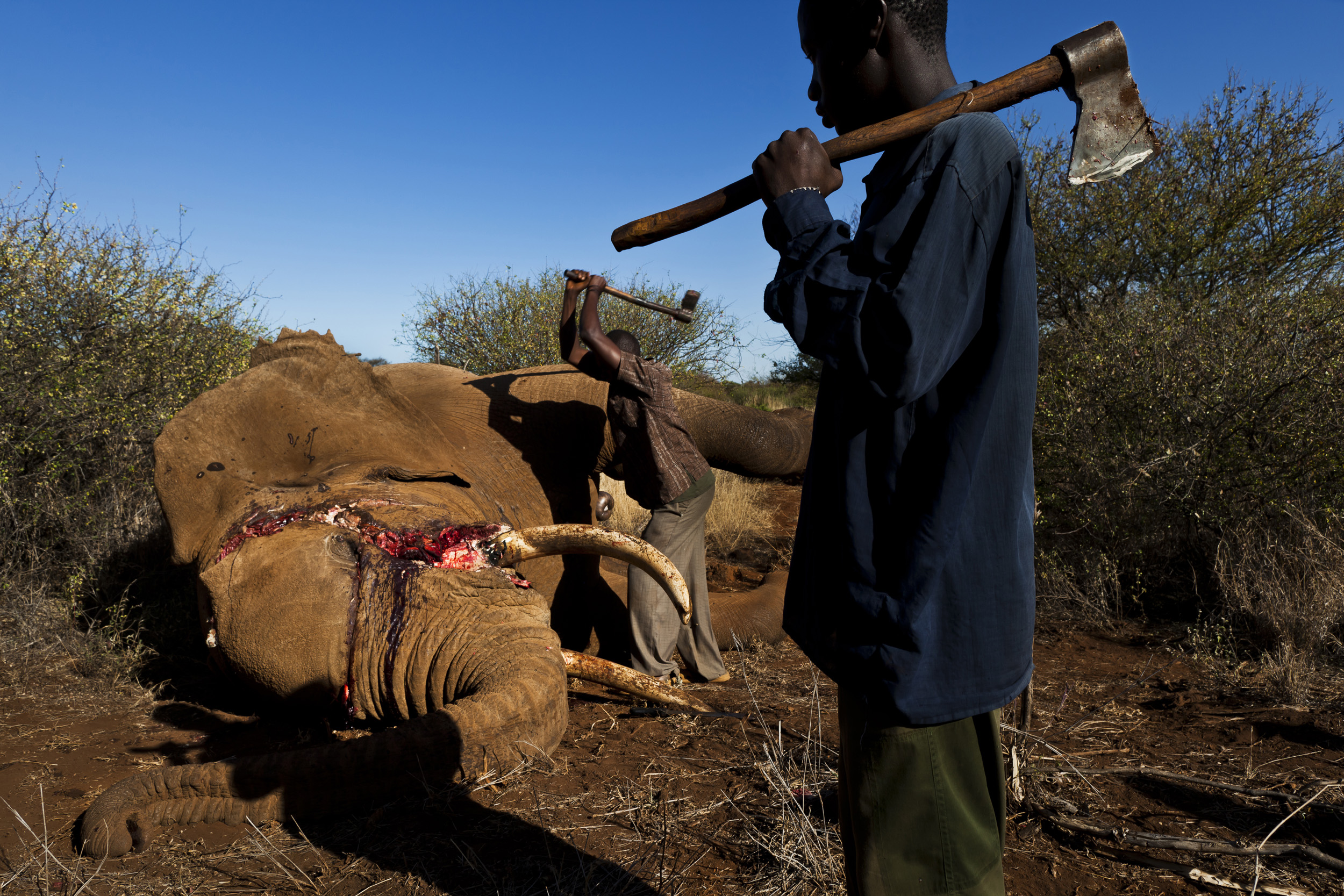
AMBOSELI, KENYA, MAY 2011: Undercover Kenya Wildlife Services Ranger detusk a bull elephant killed by a spear in the Amboseli ecosystem in the shadow of Amboseli, Kenya, May 29, 2011. The elephant was killed by a single spear stroke close to the spine which penetrated deeply enough to cause massive internal bleeding. It is not known whether this was a poaching attempt or whether this was a case of human elephant conflict with the animal in the crops of local Masaai. The animal was detusked and the ivory sent to the KWS HQ in Amboseli National Park. KWS has the mandate to protect wildlife in Kenya but lack the manpower and resources. Organisations like Big Life are the private sector arm of KWS in the 2 million acre Amboseli ecosystem, working alongside them to supply manpower, vehicles, funding, information networks and aircraft to practise effective conservation in the region. (Photo by Brent Stirton/Reportage for National Geographic Magazine.)
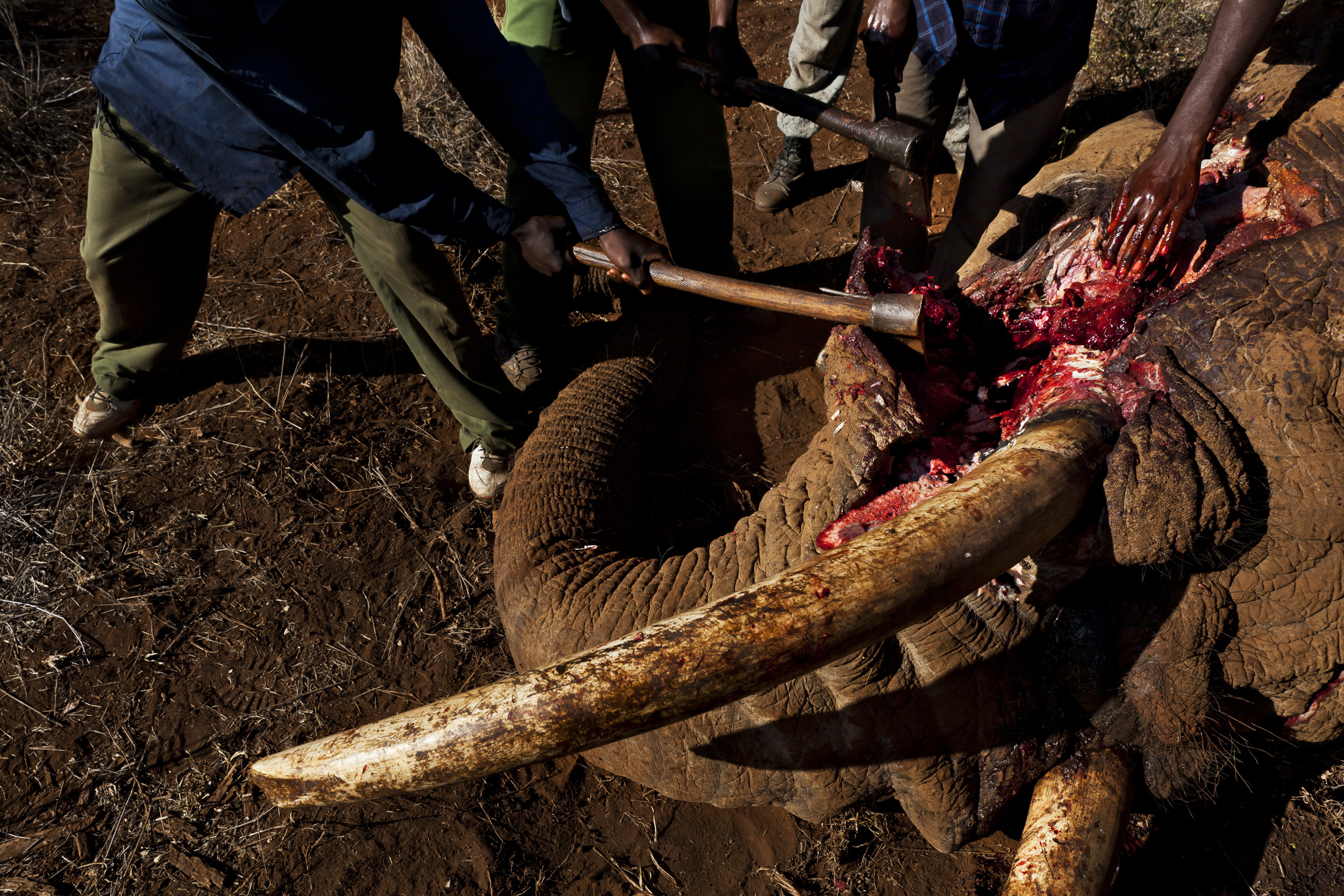
AMBOSELI, KENYA, MAY 2011: Undercover Kenya Wildlife Services Ranger detusk a bull elephant killed by a spear in the Amboseli ecosystem in the shadow of Amboseli, Kenya, May 29, 2011. The elephant was killed by a single spear stroke close to the spine which penetrated deeply enough to cause massive internal bleeding. It is not known whether this was a poaching attempt or whether this was a case of human elephant conflict with the animal in the crops of local Masaai. The animal was detusked and the ivory sent to the KWS HQ in Amboseli National Park. KWS has the mandate to protect wildlife in Kenya but lack the manpower and resources. Organisations like Big Life are the private sector arm of KWS in the 2 million acre Amboseli ecosystem, working alongside them to supply manpower, vehicles, funding, information networks and aircraft to practise effective conservation in the region. (Photo by Brent Stirton/Reportage for National Geographic Magazine.)

AMBOSELI, KENYA, MAY 2011: Undercover Kenya Wildlife Services Ranger detusk a bull elephant killed by a spear in the Amboseli ecosystem in the shadow of Amboseli, Kenya, May 29, 2011. The elephant was killed by a single spear stroke close to the spine which penetrated deeply enough to cause massive internal bleeding. It is not known whether this was a poaching attempt or whether this was a case of human elephant conflict with the animal in the crops of local Masaai. The animal was detusked and the ivory sent to the KWS HQ in Amboseli National Park. KWS has the mandate to protect wildlife in Kenya but lack the manpower and resources. Organisations like Big Life are the private sector arm of KWS in the 2 million acre Amboseli ecosystem, working alongside them to supply manpower, vehicles, funding, information networks and aircraft to practise effective conservation in the region. (Photo by Brent Stirton/Reportage for National Geographic Magazine.)
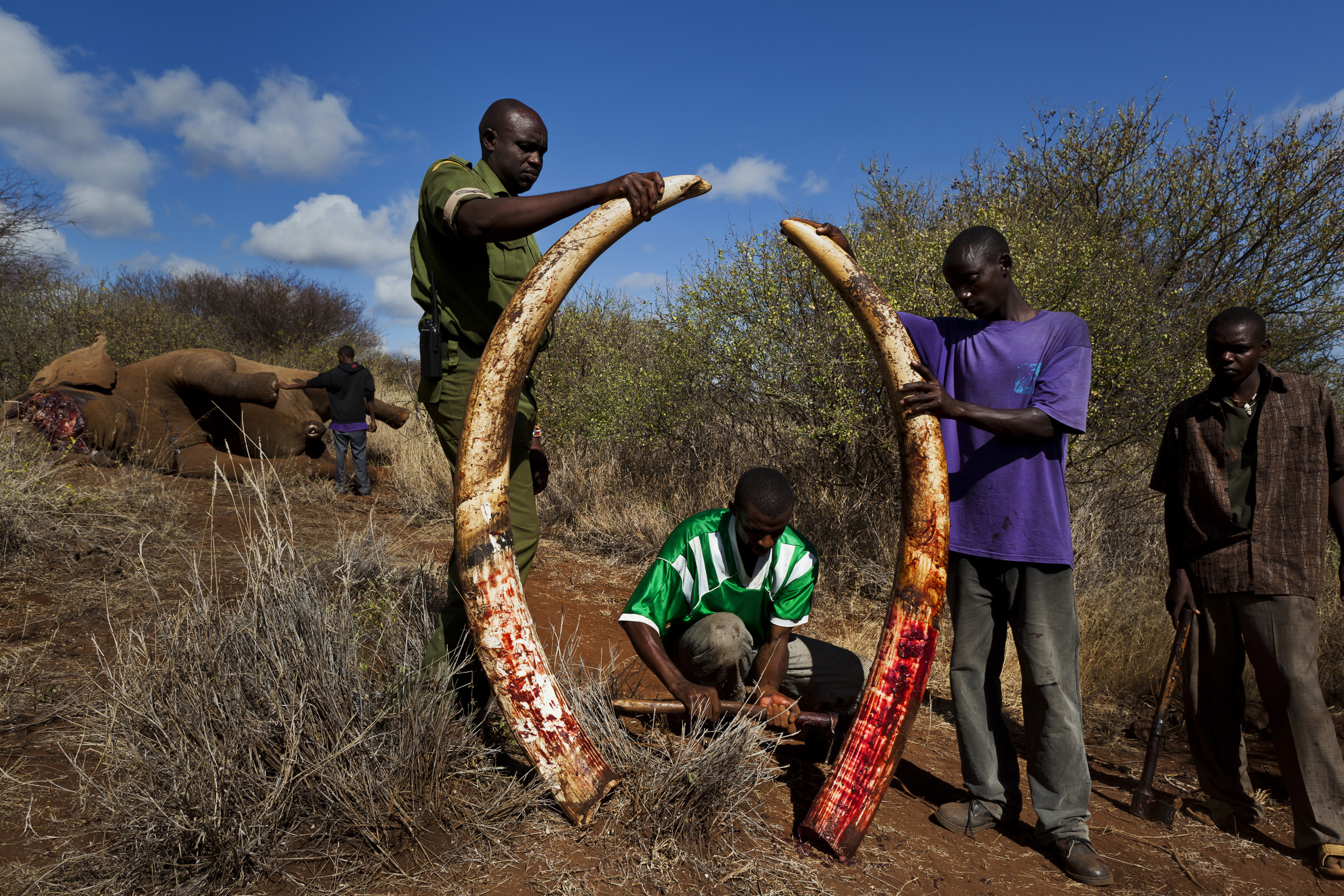
AMBOSELI, KENYA, MAY 2011: Undercover Kenya Wildlife Services Ranger detusk a bull elephant killed by a spear in the Amboseli ecosystem in the shadow of Amboseli, Kenya, May 29, 2011. The elephant was killed by a single spear stroke close to the spine which penetrated deeply enough to cause massive internal bleeding. It is not known whether this was a poaching attempt or whether this was a case of human elephant conflict with the animal in the crops of local Masaai. The animal was detusked and the ivory sent to the KWS HQ in Amboseli National Park. KWS has the mandate to protect wildlife in Kenya but lack the manpower and resources. Organisations like Big Life are the private sector arm of KWS in the 2 million acre Amboseli ecosystem, working alongside them to supply manpower, vehicles, funding, information networks and aircraft to practise effective conservation in the region. (Photo by Brent Stirton/Reportage for National Geographic Magazine.)
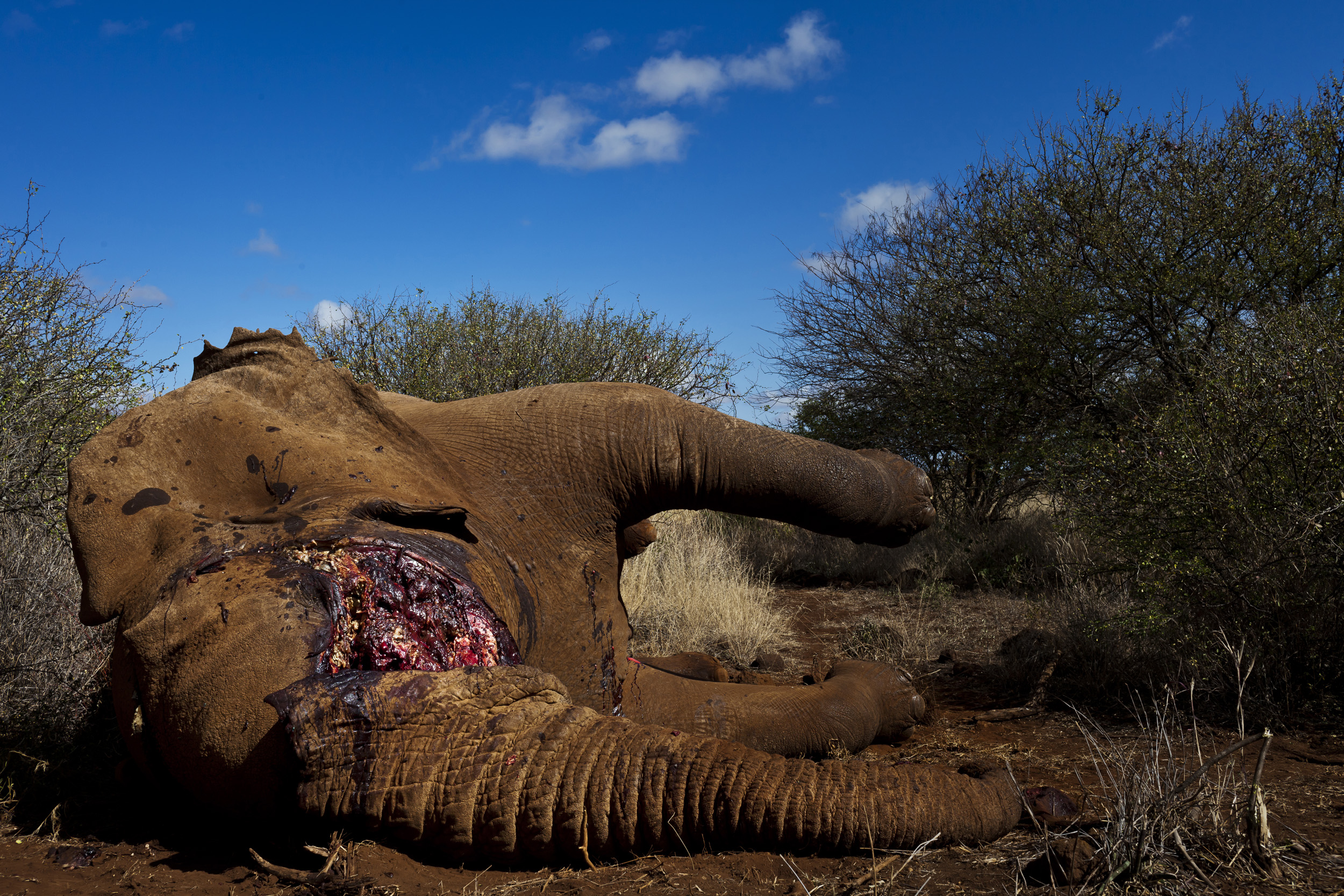
AMBOSELI, KENYA, MAY 2011: Undercover Kenya Wildlife Services Ranger detusk a bull elephant killed by a spear in the Amboseli ecosystem in the shadow of Amboseli, Kenya, May 29, 2011. The elephant was killed by a single spear stroke close to the spine which penetrated deeply enough to cause massive internal bleeding. It is not known whether this was a poaching attempt or whether this was a case of human elephant conflict with the animal in the crops of local Masaai. The animal was detusked and the ivory sent to the KWS HQ in Amboseli National Park. KWS has the mandate to protect wildlife in Kenya but lack the manpower and resources. Organisations like Big Life are the private sector arm of KWS in the 2 million acre Amboseli ecosystem, working alongside them to supply manpower, vehicles, funding, information networks and aircraft to practise effective conservation in the region. (Photo by Brent Stirton/Reportage for National Geographic Magazine.)
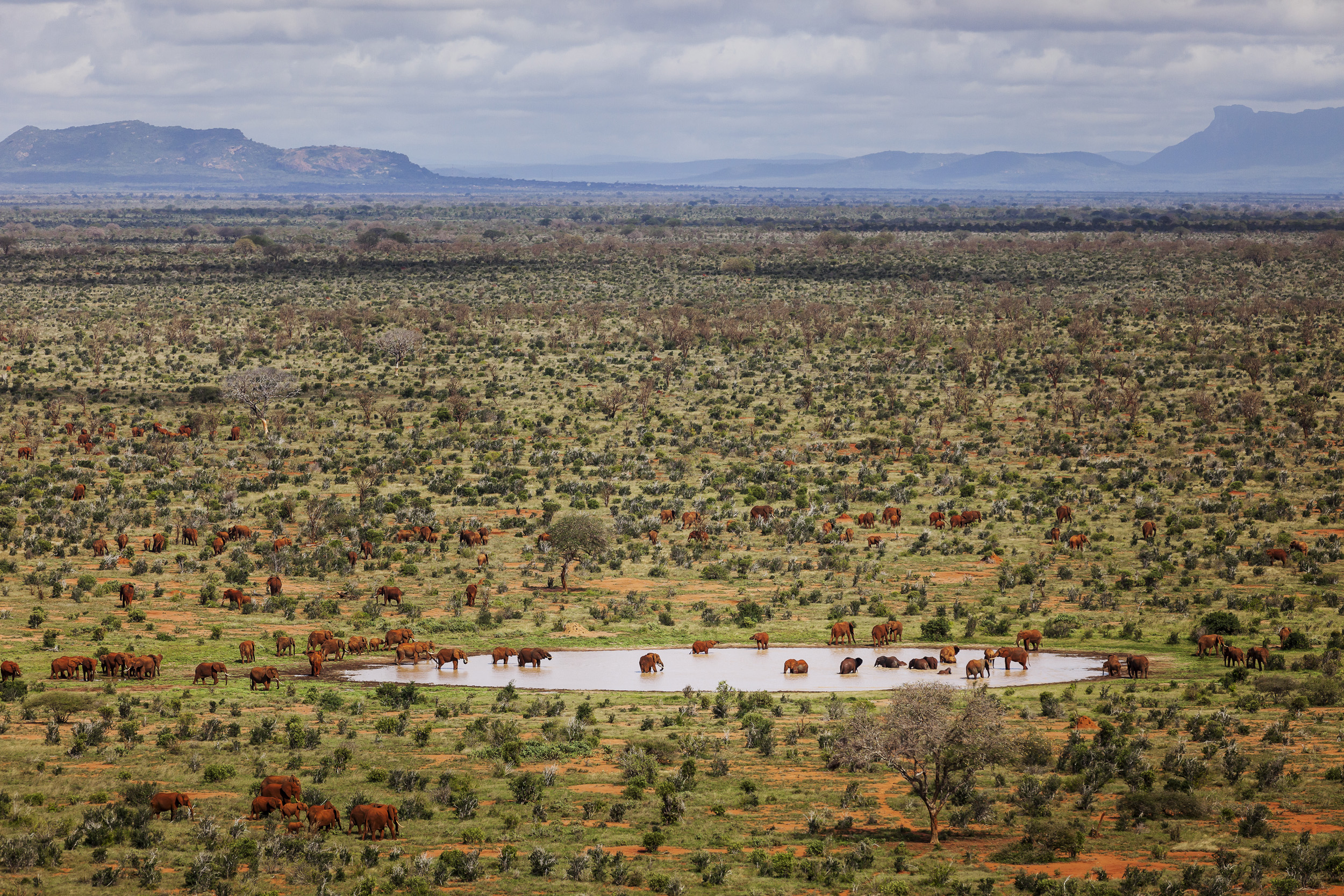
TSAVO EAST, KENYA, MAY 2011: Images of some of the last of the great Elephant tuskers in Africa, taken in Tsavo Eastm 18 May, 2011. Massive elephant poaching in recent years has seen most of the mature bull elephant population of African countries decimated for their ivory. A Tusker is defined as an elephant with a set of 100 pound ivory tusks, or therabouts. This depletion of the elephant gene pool is having a negative effect on populations, with weak dna being passed on instead of the strongest. (Photo by Brent Stirton/Reportage for National Geographic Magazine.)

LULIMBI, EASTERN DRC, FEBRUARY 2012: ICCN Rangers investigate the corpse of a recently killed sub-adult male elephant in Lulimbi, Eastern DRC, February 29, 2012. The elephant has obviously been killed for its ivory, a trend on the rise across the DRC and one which makes the Rangers job very difficult. (Photo by Brent Stirton/Reportage for Geo magazine.)
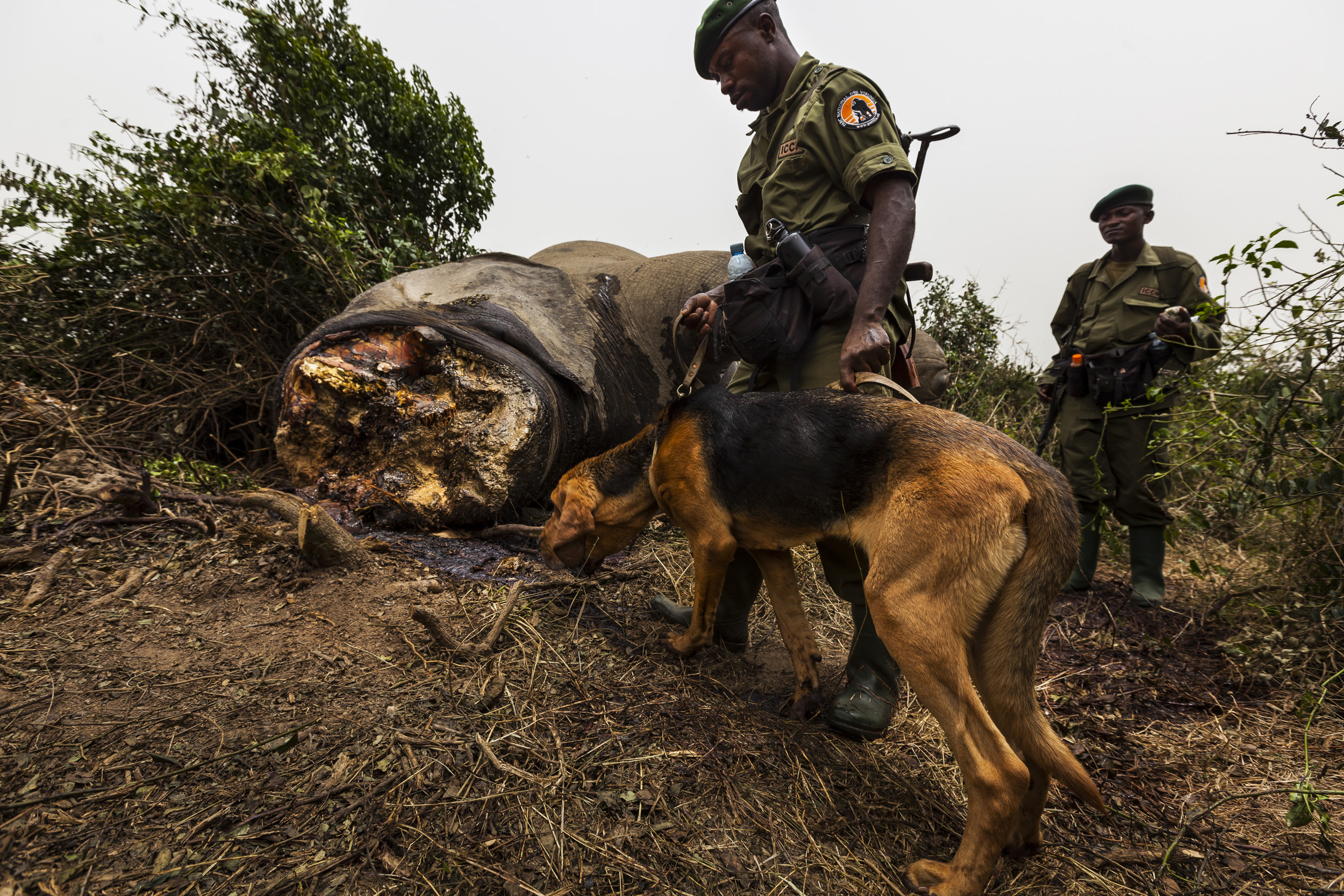
LULIMBI, EASTERN DRC, FEBRUARY 2012: ICCN Conservation Rangers deploy young bloodhounds for the first time in Virunga to investigate the corpse of a recently killed sub-adult male elephant in Lulimbi, Eastern DRC, February 29, 2012. The elephant had obviously been killed for its ivory, a trend on the rise across the DRC and one which makes the Rangers job very difficult. The young dogs reacted with horror at the elephant corpse, their noses are estimated to be 3 million times more sensitive than a humans. After initially recoiling, the lead dog Lily, just over a year old, took the scent and followed it for several kilometers in the exact direction of a fishing village on Lake Edward long suspected in poaching cases in Virunga. She was pulled off the trail once Rangers knew where the suspects came from. Undercover intelligence will now be used in the village to seek out the sellers. (Photo by Brent Stirton/Reportage for Geo magazine.)

LULIMBI, EASTERN DRC, FEBRUARY 2012: ICCN Conservation Rangers deploy young bloodhounds for the first time in Virunga to investigate the corpse of a recently killed sub-adult male elephant in Lulimbi, Eastern DRC, February 29, 2012. The elephant had obviously been killed for its ivory, a trend on the rise across the DRC and one which makes the Rangers job very difficult. The young dogs reacted with horror at the elephant corpse, their noses are estimated to be 3 million times more sensitive than a humans. After initially recoiling, the lead dog Lily, just over a year old, took the scent and followed it for several kilometers in the exact direction of a fishing village on Lake Edward long suspected in poaching cases in Virunga. She was pulled off the trail once Rangers knew where the suspects came from. Undercover intelligence will now be used in the village to seek out the sellers. (Photo by Brent Stirton/Reportage for Geo magazine.)

CHONDO, VIRUNGA NATIONAL PARK, DEMOCRATIC REPUBLIC OF CONGO, MARCH 2012: A combined team of ICCN Congolese conservation rangers and members of the Congolese army patrol an area known to have a FDLR rebel presence, Chondo, Virunga, 12 March 2012. The FDLR are the hardcore Hutu's who were behind the Rwandan massacre of 1994. Since they fled into the DRC and the park after the Genocide, they have sown mayhem and destruction in Virunga. 140 Rangers have died defending Virunga since 1994, many at the hands of the FDLR rebels. There are regular contacts between the Rangers and FDLR, usually resulting in injuries and deaths on either side. The Rangers, with the help of the FARDC, are winning this battle but at a heavy price. In 2011 eleven Rangers died fighting the FDLR. Virunga remains one of the most dangerous places in the world to practise conservation. (Photo by Brent Stirton/Reportage for GEO magazine.)

CHONDO, VIRUNGA NATIONAL PARK, DEMOCRATIC REPUBLIC OF CONGO, MARCH 2012: ICCN Congolese conservation rangers and members of the Congolese army capture illegal fisherman, Chondo, Virunga, 12 March 2012. Many of these fisherman are involved in this activity due to poverty, others are there to supply the rebel FDLR group with food. The FDLR are the hardcore Hutu's who were behind the Rwandan massacre of 1994. The fish stocks in the lake are just beginning to recover from the war, thousands of hippos were slaughtered to feed militia groups and this devastated fish stocks. This delicate recovery is what the ICCN rangers are trying to protect. This will allow a viable and sustainable fishing industry to be generated at Lake Edward, for the benefit of all. Since the FDLR fled into Virunga after the Genocide, they have sown mayhem and destruction in Virunga. 140 Rangers have died defending Virunga since 1994, many at the hands of the FDLR rebels. There are regular contacts between the Rangers and FDLR, usually resulting in injuries and deaths on either side. The Rangers, with the help of the FARDC, are winning this battle but at a heavy price. In 2011 eleven Rangers died fighting the FDLR. Virunga remains one of the most dangerous places in the world to practise conservation. (Photo by Brent Stirton/Reportage for GEO magazine.)
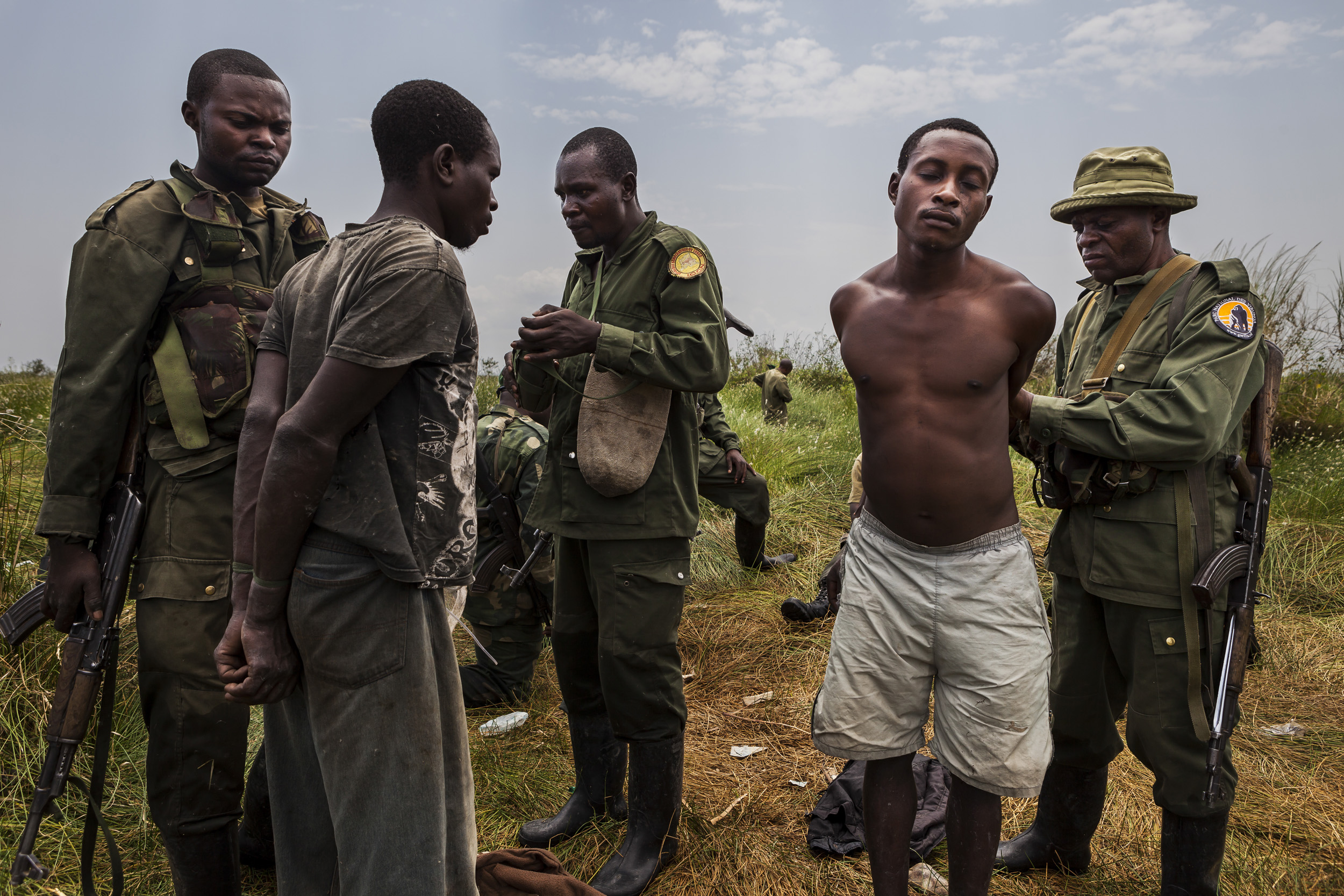
CHONDO, VIRUNGA NATIONAL PARK, DEMOCRATIC REPUBLIC OF CONGO, MARCH 2012: ICCN Congolese conservation rangers and members of the Congolese army capture illegal fisherman, Chondo, Virunga, 12 March 2012. Many of these fisherman are involved in this activity due to poverty, others are there to supply the rebel FDLR group with food. The FDLR are the hardcore Hutu's who were behind the Rwandan massacre of 1994. The fish stocks in the lake are just beginning to recover from the war, thousands of hippos were slaughtered to feed militia groups and this devastated fish stocks. This delicate recovery is what the ICCN rangers are trying to protect. This will allow a viable and sustainable fishing industry to be generated at Lake Edward, for the benefit of all. Since the FDLR fled into Virunga after the Genocide, they have sown mayhem and destruction in Virunga. 140 Rangers have died defending Virunga since 1994, many at the hands of the FDLR rebels. There are regular contacts between the Rangers and FDLR, usually resulting in injuries and deaths on either side. The Rangers, with the help of the FARDC, are winning this battle but at a heavy price. In 2011 eleven Rangers died fighting the FDLR. Virunga remains one of the most dangerous places in the world to practise conservation. (Photo by Brent Stirton/Reportage for GEO magazine.)

BOUBA NDJIDA NATIONAL PARK, NORTH CAMEROON, APRIL 2012: The largest mass killing of elephants in recent history took place at Bouba Ndjida National Park in North Cameroon close to the Chad and Central African Republic Borders from January through March 2012. Eye witnesses have so far located 340 carcasses, the ivory poachers themselves told local villagers they have killed over 650 elephants in their hunt for Ivory over the 500 000 hectare region. There has yet to be a proper aerial and ground survey of the dead elephants and the rainy season will make that difficult. The Poachers, numbering over 100 men, were mounted on horseback, led by 6 light skinned North Sudanese men and armed with RPG's, grenades, Light Machine Guns and AK47's. They were in two main groups, with a number of reconnaisance units of 4 men locating the elephants then bringing in a larger force to kill big groups. Intelligence indicates that many of the hunters came from Chad and were led by these Sudanese men. These facts have emerged from a number of eye witness acccounts, mainly by French professional hunters who saw the horsman in the Park and local hunting concessions. They had the appearence and attitude of Janjaweed fighters from the South Sudan Darfur and Chadian conflicts and were disciplined, unafraid, arrogant and extremely efficient hunters. The elephants were herded together by teams of 4 to 8 riders who then decimated them with AK47 fire, killing all the elephants they could find, including babies with no ivory. Groups as large as 53 have been gunned down together, with sections as large as 14 elephants lying within touching distance of each other. These horseman came into the area over the Chadian border, evidence of early carcasses suggests that they may have been in the park as early as October 2011. The main force began their hunt in earnest from January through to approximately 8 March 2012. It is believed there was collaboration with local poachers in this hunt as well as an as

BOUBA NDJIDA NATIONAL PARK, NORTH CAMEROON, APRIL 2012: The largest mass killing of elephants in recent history took place at Bouba Ndjida National Park in North Cameroon close to the Chad and Central African Republic Borders from January through March 2012. Eye witnesses have so far located 340 carcasses, the ivory poachers themselves told local villagers they have killed over 650 elephants in their hunt for Ivory over the 500 000 hectare region. There has yet to be a proper aerial and ground survey of the dead elephants and the rainy season will make that difficult. The Poachers, numbering over 100 men, were mounted on horseback, led by 6 light skinned North Sudanese men and armed with RPG's, grenades, Light Machine Guns and AK47's. They were in two main groups, with a number of reconnaisance units of 4 men locating the elephants then bringing in a larger force to kill big groups. Intelligence indicates that many of the hunters came from Chad and were led by these Sudanese men. These facts have emerged from a number of eye witness acccounts, mainly by French professional hunters who saw the horsman in the Park and local hunting concessions. They had the appearence and attitude of Janjaweed fighters from the South Sudan Darfur and Chadian conflicts and were disciplined, unafraid, arrogant and extremely efficient hunters. The elephants were herded together by teams of 4 to 8 riders who then decimated them with AK47 fire, killing all the elephants they could find, including babies with no ivory. Groups as large as 53 have been gunned down together, with sections as large as 14 elephants lying within touching distance of each other. These horseman came into the area over the Chadian border, evidence of early carcasses suggests that they may have been in the park as early as October 2011. The main force began their hunt in earnest from January through to approximately 8 March 2012. It is believed there was collaboration with local poachers in this hunt as well as an as
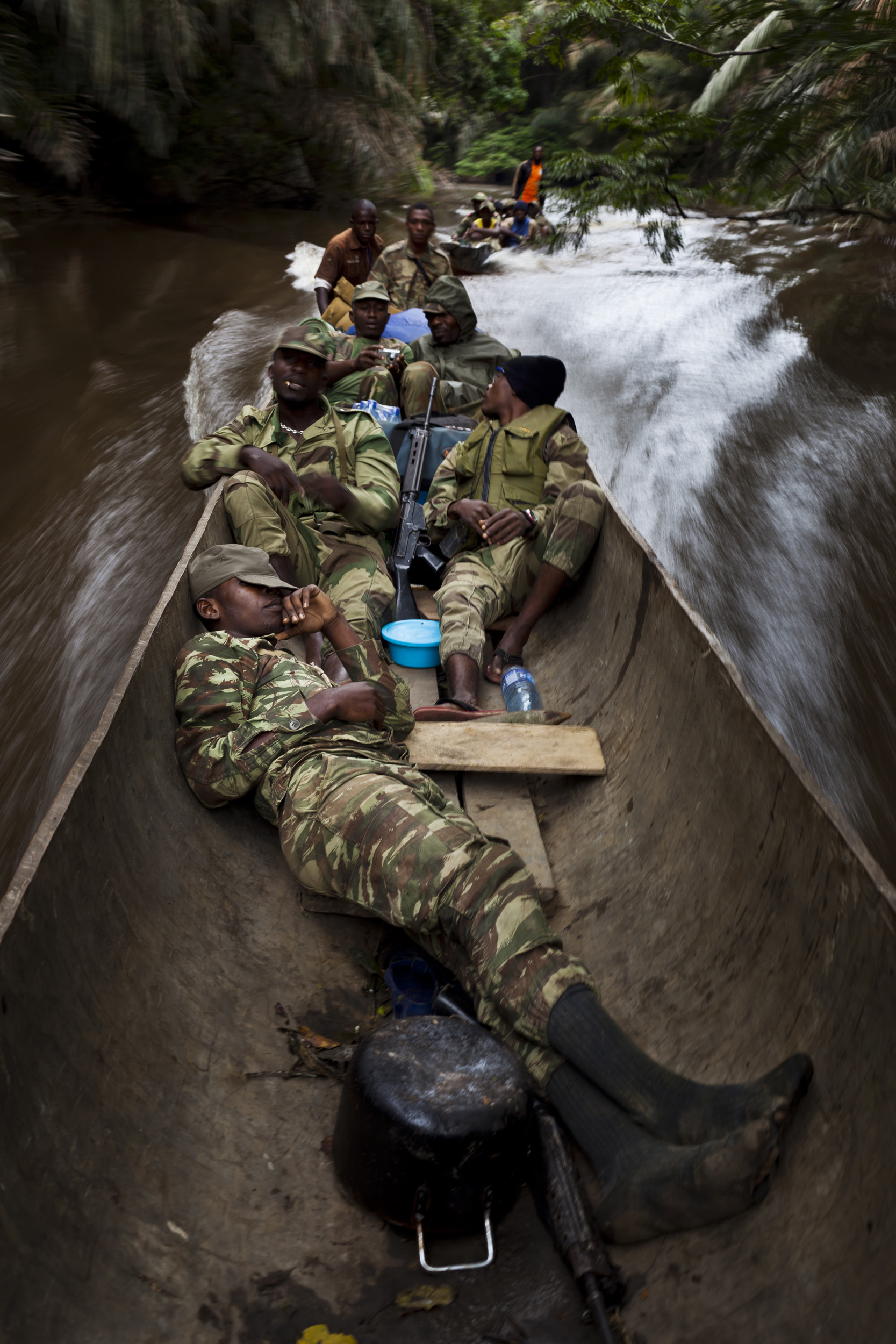
SING RIVER, MINKEBI NATIONAL PARK, GABON, JUNE 2011: An anti-poaching team composed of Gabon Parcs personal, Gabon military, Baka pygmy porters and two Pirouge pilots conduct an anti-poaching mission up the Sing River in Minkebi National Park, Gabon, 26 June 2011. Gabon has recently seen a large spate of Elephant killings as a result of thousands of illegal goldminers that had flooded into the Minkebi region to exploit a lack of the rule of law in the reserve. Approximately a month ago the Gabonese military and Gabon Parcs Department conducted a large joint operation, inviting all these illegal miners to go home to their own countries or face detention. The presence of these illegals also created a thriving illegal ivory industry, fueled by the presence of Chinese traders in Gabon and neighbouring Congo Brazzaville and Cameroon. This expedition up the Sing River was to check for the presence of these illegals and to see if they were carrying out any poaching activity. There were no sightings and now only empty mining settelements remain. It appears the initial operations have put the word out and the illegal miners and poaching villages are no more in this region of Gabon. The operation involved travelling far up the Sing River in Minkbebi Park, cutting river pathways for the pirouges and doing a thorough check for poachers all the way up the river. There are plans for a permanent "Jungle Brigade" for this region within the next 6 months and that should safeguard the borders of Gabon and its wildlife from further poaching threats. (Photo by Brent Stirton/National Geographic.)

MAKOUKOU, GABON, JUNE 2011: Gabon National Parks personal catalog recently confiscated poacher's guns and ivory at the Makoukou courts building close to Minkebi National Park, Makoukou, Gabon, June 23, 2011. The combined presence of thousands of illegal immigrant goldminers in the national parks of the north as well as the presence of the Chinese in Gabon has dramatically affected the demand for ivory and had a direct impact on forest elephant poaching in the national parks of Gabon. The rise of the Asian middle class has seen far more money availble for Ivory and an unprecedented rise in elephant killings as a result. In May 2011 the Gabon Military and the Gabon Parks authority launched an all out action against the illegal miners in the park and "politely asked them all the return to their own countries the way they came. " Most illegals have now returned to Cameroon and Congo Brazzaville but there are still a number of illegal hunting camps in the forests. The Gabonese Parks authority and the Gabon Military and Police have combined forces in a campaign to clear the forest of all these illegals who are killing elephants and stealing gold from Gabon. This campaign will go on for the next 6 months and thereafter a jungle brigade of paramilitary police will patrol the parks and the borders. (Photo by Brent Stirton/Reportage for National Geographic.)

IVINDO, GABON, JULY 2011: A suspected elephant poacher wounded by an enraged elephant examines his healing injury under the gaze of hip-hop posters which adorn his home in Ivindo, Gabon, July 3, 2011. This man claims he shot at the elephant in self-defence but this is the second time he and two accomplices have been implicated in a self-defence incident involving elephant this year. They claimed to have been hunting bush-pig but the calibre of weapon they were using as well as the fact that they have been involved in two elephant incidents recently has led Gabon Parcs authorities to suspect their true motives to be elephant poaching for ivory. The fact that the ivory of one of the elephants they claim to have killed in self-defence is missing further compounds their guilt in the eyes of the authorities. The man pictured, Hubert Mebouaya, 26, claims they were hunting for bush-pig when he and his two friends were set upon by an elephant, he tried to run but was trapped by vines.The elephant gored him and he sustained injuries to his chest, narrowly avoiding a punctured lung. He walked 8km out of the forest with the help of his friends and ended up in hospital for two weeks in recovery. (Photo by Brent Stirton/Reportage for National Geographic.)

MANYANI, TSAVO, KENYA, JULY 2011: The preparation for the burning of 5 tons of trafficked Ivory recovered from a seizure in Singapore in 2002, Manyani, Tsavo, Kenya, 20 July 2011. The ivory to be burnt is originally from Malawi and Zambia, 5 tons of the original 6.4 tons were burnt and the remainder will supposedly be sent back to the 2 countries of origin, Malawi and Zambia. It will be burnt in Kenya under the auspices of the LATF, the Lusaka Task Force, a group of affiliated countries who are supposed to form a common front against wildlife crime in Africa. The ivory burning is regarded with some cynicism from conservation quarters, no Kenyan ivory was added to the pyre, despite stocks in excess of 65 tons and their appropriation of the PR value of this event. The Kenyans response is to say that the disposal of public assets is a parlimentary affair, with due process of the law. The minimum time it would take for this is 3 months, more than enough time for Kenya to have participated if it so chose. Wildlife crime in Kenya still remains a perceived minor crime, with a maximum fine of only $430 for the killing of an elephant for its tusks. In conservation circles this illustrates a lack of comittment on the part of the KWS to truly stamp out the illegal ivory trade within Kenya. The overwhelming perception is that KWS appropriated this event, with minimum participation from the other LATF countries, and no credit was given to the Environmental Impact Agency despite the fact that it was their intelligence operation which resulted in the seizure in the first place. KWS also attempted to charge all foreign media a fee of $700 to attend the burn, despite them being invited guests to the burning and an indispensable source of publicity for Kenya's supposed anti-ivory trade stance. (Photo by Brent Stirton/Reportage for National Geographic.)

MANYANI, TSAVO, KENYA, JULY 2011: The preparation for the burning of 5 tons of trafficked Ivory recovered from a seizure in Singapore in 2002, Manyani, Tsavo, Kenya, 20 July 2011. The ivory to be burnt is originally from Malawi and Zambia, 5 tons of the original 6.4 tons were burnt and the remainder will supposedly be sent back to the 2 countries of origin, Malawi and Zambia. It will be burnt in Kenya under the auspices of the LATF, the Lusaka Task Force, a group of affiliated countries who are supposed to form a common front against wildlife crime in Africa. The ivory burning is regarded with some cynicism from conservation quarters, no Kenyan ivory was added to the pyre, despite stocks in excess of 65 tons and their appropriation of the PR value of this event. The Kenyans response is to say that the disposal of public assets is a parlimentary affair, with due process of the law. The minimum time it would take for this is 3 months, more than enough time for Kenya to have participated if it so chose. Wildlife crime in Kenya still remains a perceived minor crime, with a maximum fine of only $430 for the killing of an elephant for its tusks. In conservation circles this illustrates a lack of comittment on the part of the KWS to truly stamp out the illegal ivory trade within Kenya. The overwhelming perception is that KWS appropriated this event, with minimum participation from the other LATF countries, and no credit was given to the Environmental Impact Agency despite the fact that it was their intelligence operation which resulted in the seizure in the first place. KWS also attempted to charge all foreign media a fee of $700 to attend the burn, despite them being invited guests to the burning and an indispensable source of publicity for Kenya's supposed anti-ivory trade stance. (Photo by Brent Stirton/Reportage for National Geographic.)
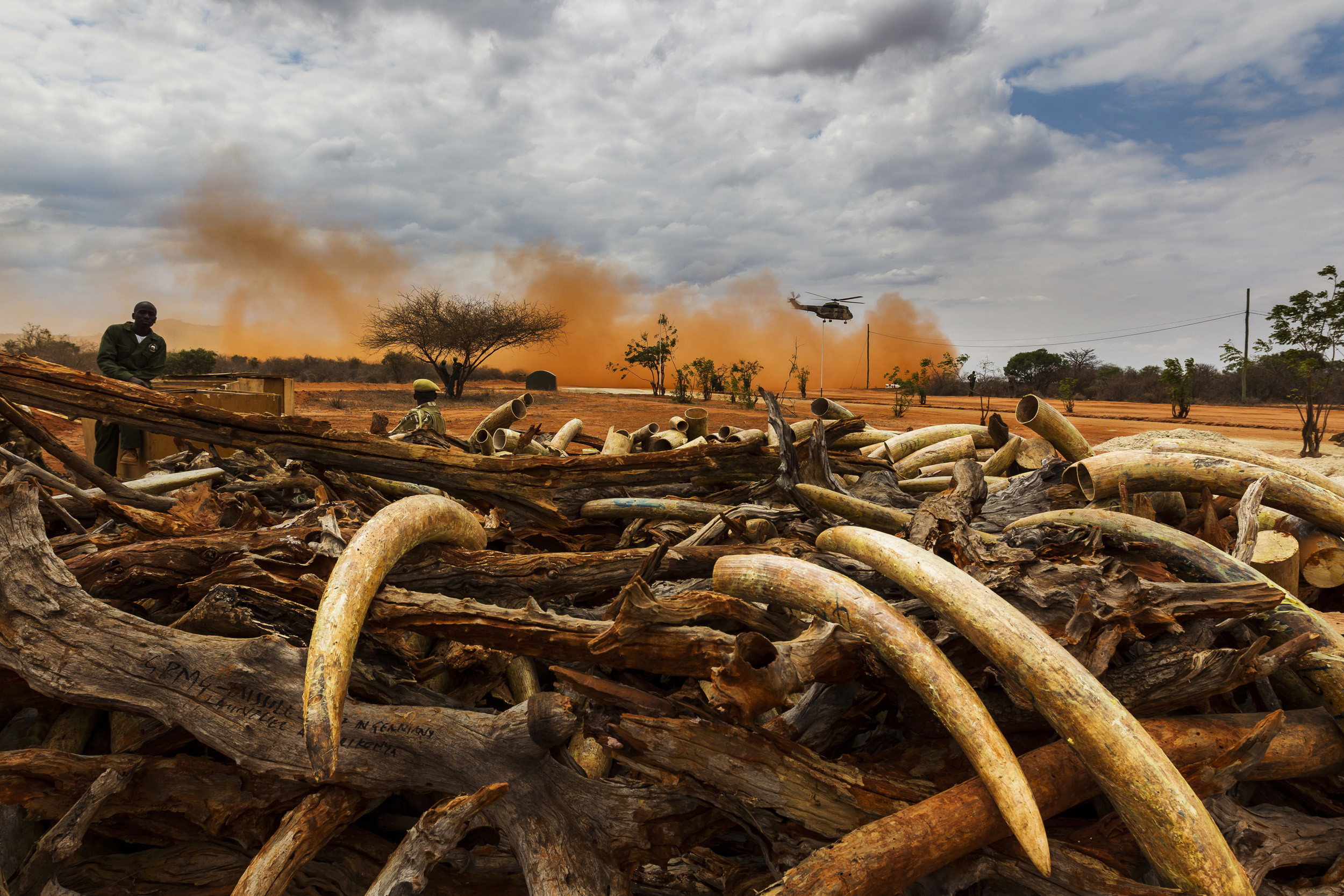
MANYANI, TSAVO, KENYA, JULY 2011: The preparation for the burning of 5 tons of trafficked Ivory recovered from a seizure in Singapore in 2002, Manyani, Tsavo, Kenya, 20 July 2011. The ivory to be burnt is originally from Malawi and Zambia, 5 tons of the original 6.4 tons were burnt and the remainder will supposedly be sent back to the 2 countries of origin, Malawi and Zambia. It will be burnt in Kenya under the auspices of the LATF, the Lusaka Task Force, a group of affiliated countries who are supposed to form a common front against wildlife crime in Africa. The ivory burning is regarded with some cynicism from conservation quarters, no Kenyan ivory was added to the pyre, despite stocks in excess of 65 tons and their appropriation of the PR value of this event. The Kenyans response is to say that the disposal of public assets is a parlimentary affair, with due process of the law. The minimum time it would take for this is 3 months, more than enough time for Kenya to have participated if it so chose. Wildlife crime in Kenya still remains a perceived minor crime, with a maximum fine of only $430 for the killing of an elephant for its tusks. In conservation circles this illustrates a lack of comittment on the part of the KWS to truly stamp out the illegal ivory trade within Kenya. The overwhelming perception is that KWS appropriated this event, with minimum participation from the other LATF countries, and no credit was given to the Environmental Impact Agency despite the fact that it was their intelligence operation which resulted in the seizure in the first place. KWS also attempted to charge all foreign media a fee of $700 to attend the burn, despite them being invited guests to the burning and an indispensable source of publicity for Kenya's supposed anti-ivory trade stance. (Photo by Brent Stirton/Reportage for National Geographic.)

MANYANI, TSAVO, KENYA, JULY 2011: The preparation for the burning of 5 tons of trafficked Ivory recovered from a seizure in Singapore in 2002, Manyani, Tsavo, Kenya, 20 July 2011. The ivory to be burnt is originally from Malawi and Zambia, 5 tons of the original 6.4 tons were burnt and the remainder will supposedly be sent back to the 2 countries of origin, Malawi and Zambia. It will be burnt in Kenya under the auspices of the LATF, the Lusaka Task Force, a group of affiliated countries who are supposed to form a common front against wildlife crime in Africa. The ivory burning is regarded with some cynicism from conservation quarters, no Kenyan ivory was added to the pyre, despite stocks in excess of 65 tons and their appropriation of the PR value of this event. The Kenyans response is to say that the disposal of public assets is a parlimentary affair, with due process of the law. The minimum time it would take for this is 3 months, more than enough time for Kenya to have participated if it so chose. Wildlife crime in Kenya still remains a perceived minor crime, with a maximum fine of only $430 for the killing of an elephant for its tusks. In conservation circles this illustrates a lack of comittment on the part of the KWS to truly stamp out the illegal ivory trade within Kenya. The overwhelming perception is that KWS appropriated this event, with minimum participation from the other LATF countries, and no credit was given to the Environmental Impact Agency despite the fact that it was their intelligence operation which resulted in the seizure in the first place. KWS also attempted to charge all foreign media a fee of $700 to attend the burn, despite them being invited guests to the burning and an indispensable source of publicity for Kenya's supposed anti-ivory trade stance. (Photo by Brent Stirton/Reportage for National Geographic.)

MANYANI, TSAVO, KENYA, JULY 2011: The burning of 5 tons of trafficked Ivory recovered from a seizure in Singapore in 2002, Manyani, Tsavo, Kenya, 20 July 2011. The ivory burnt here was originally from Malawi and Zambia, 5 tons of the original 6.4 tons were burnt and the remainder will supposedly be sent back to the 2 countries of origin, Malawi and Zambia. It was burnt in Kenya under the auspices of the LATF, the Lusaka Task Force, a group of affiliated countries who are supposed to form a common front against wildlife crime in Africa. The ivory burning is regarded with some cynicism from conservation quarters, no Kenyan ivory was added to the pyre, despite stocks in excess of 65 tons and their appropriation of the PR value of this event. The Kenyans response is to say that the disposal of public assets is a parlimentary affair, with due process of the law. The minimum time it would take for this is 3 months, more than enough time for Kenya to have participated if it so chose. Wildlife crime in Kenya still remains a perceived minor crime, with a maximum fine of only $430 for the killing of an elephant for its tusks. In conservation circles this illustrates a lack of comittment on the part of the KWS to truly stamp out the illegal ivory trade within Kenya. The overwhelming perception is that KWS appropriated this event, with minimum participation from the other LATF countries, and no credit was given to the Environmental Impact Agency despite the fact that it was their intelligence operation which resulted in the seizure in the first place. KWS also attempted to charge all foreign media a fee of $700 to attend the burn, despite them being invited guests to the burning and an indispensable source of publicity for Kenya's supposed anti-ivory trade stance. (Photo by Brent Stirton/Reportage for National Geographic.)
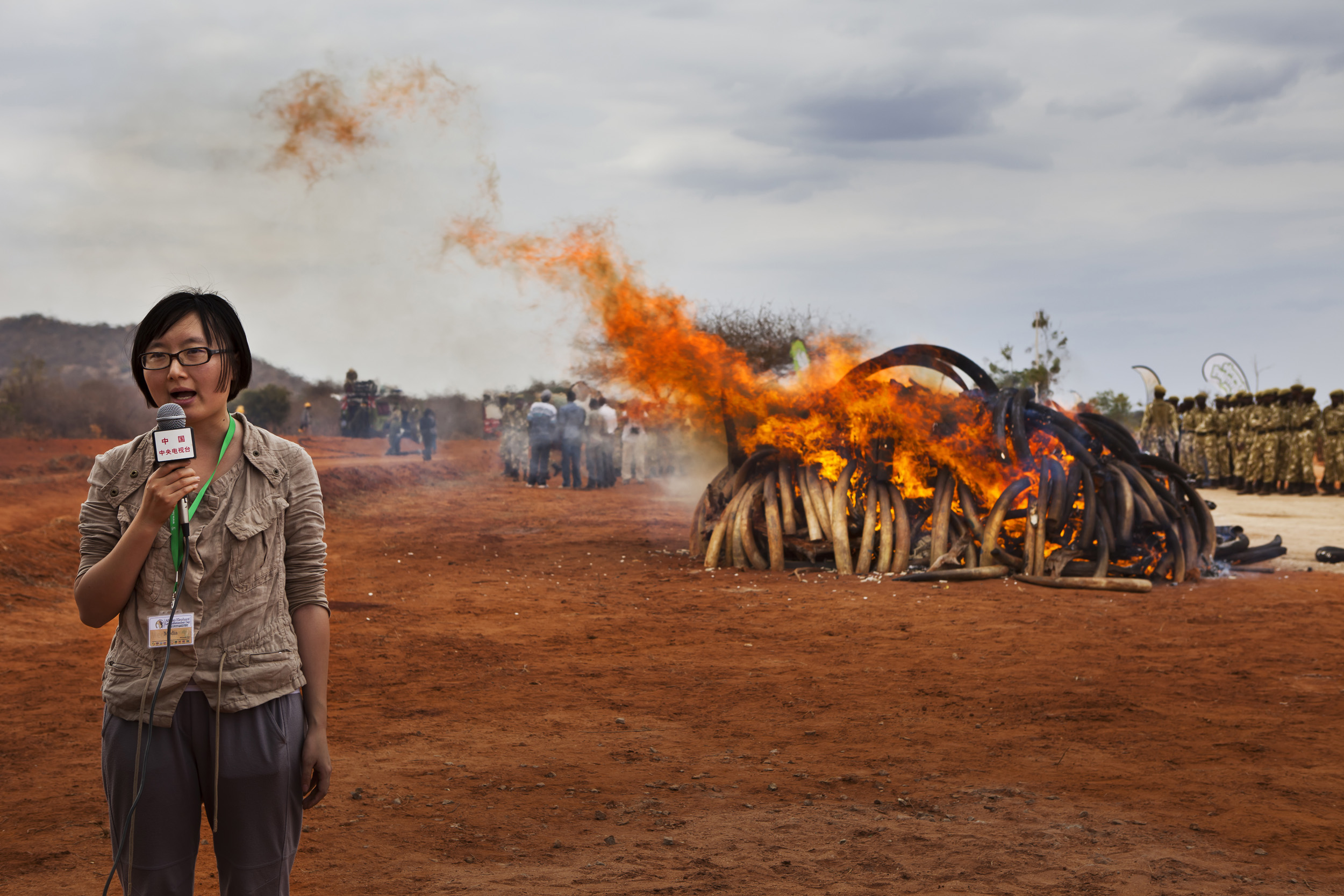
MANYANI, TSAVO, KENYA, JULY 2011: The burning of 5 tons of trafficked Ivory recovered from a seizure in Singapore in 2002, Manyani, Tsavo, Kenya, 20 July 2011. The ivory burnt here was originally from Malawi and Zambia, 5 tons of the original 6.4 tons were burnt and the remainder will supposedly be sent back to the 2 countries of origin, Malawi and Zambia. It was burnt in Kenya under the auspices of the LATF, the Lusaka Task Force, a group of affiliated countries who are supposed to form a common front against wildlife crime in Africa. The ivory burning is regarded with some cynicism from conservation quarters, no Kenyan ivory was added to the pyre, despite stocks in excess of 65 tons and their appropriation of the PR value of this event. The Kenyans response is to say that the disposal of public assets is a parlimentary affair, with due process of the law. The minimum time it would take for this is 3 months, more than enough time for Kenya to have participated if it so chose. Wildlife crime in Kenya still remains a perceived minor crime, with a maximum fine of only $430 for the killing of an elephant for its tusks. In conservation circles this illustrates a lack of comittment on the part of the KWS to truly stamp out the illegal ivory trade within Kenya. The overwhelming perception is that KWS appropriated this event, with minimum participation from the other LATF countries, and no credit was given to the Environmental Impact Agency despite the fact that it was their intelligence operation which resulted in the seizure in the first place. KWS also attempted to charge all foreign media a fee of $700 to attend the burn, despite them being invited guests to the burning and an indispensable source of publicity for Kenya's supposed anti-ivory trade stance. (Photo by Brent Stirton/Reportage for National Geographic.)
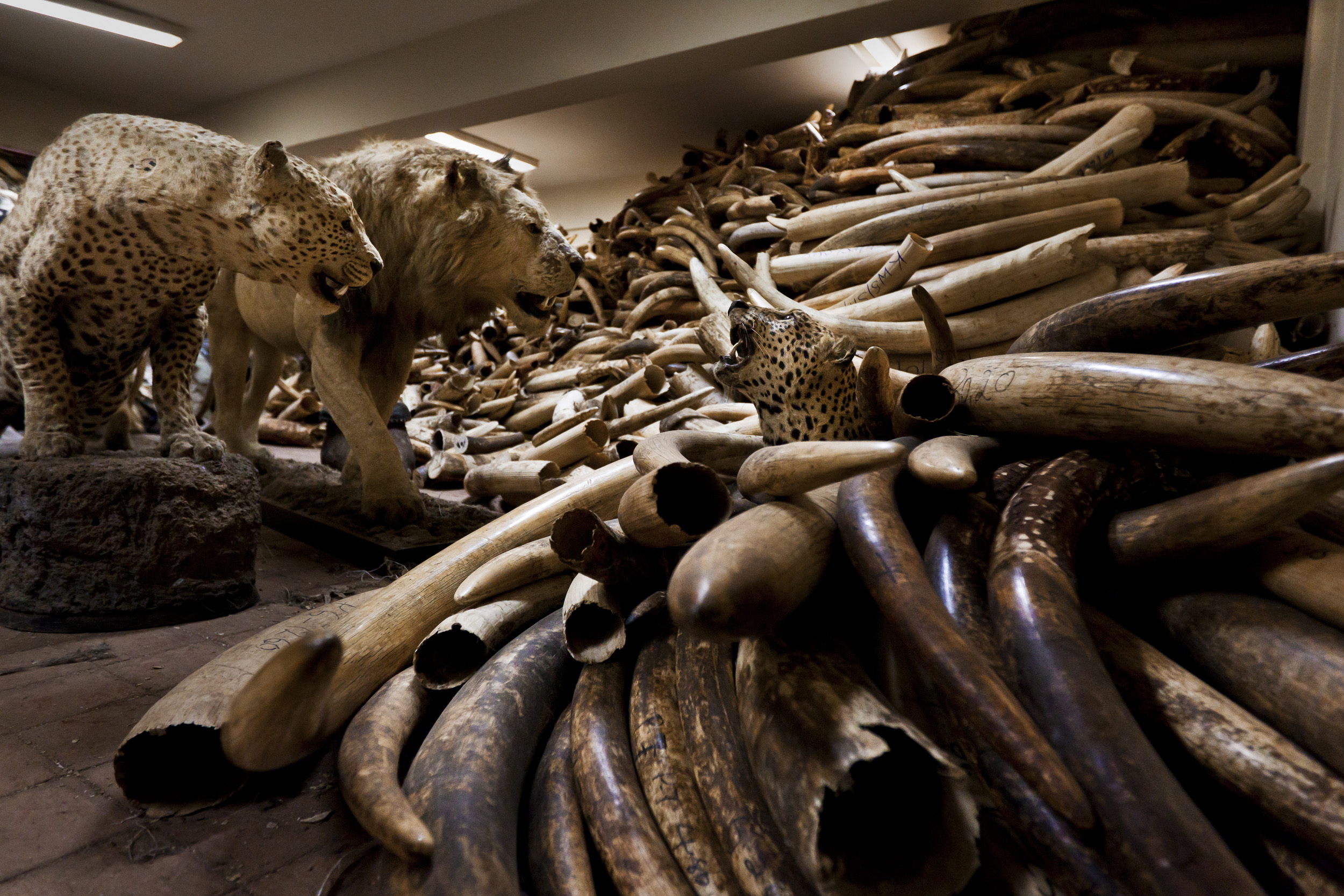
NAIROBI, KENYA, JULY 2011: Inside the Ivory strongroom underneath the Kenya Wildlife Service HQ in Nairobi, Kenya, July 29, 2011. According to the Director of KWS, Julius Kipnegitch, they have around 65 tons of Ivory in storage, some from illegal ivory busts, some from natural mortality in Kenyan elephants. Kenya has a strong public anti-trade stance on ivory trading and claims to have other plans for its ivory, including possibly using it in a wildlife museum setting. (Photo by Brent Stirton/Reportage for National Geographic.)
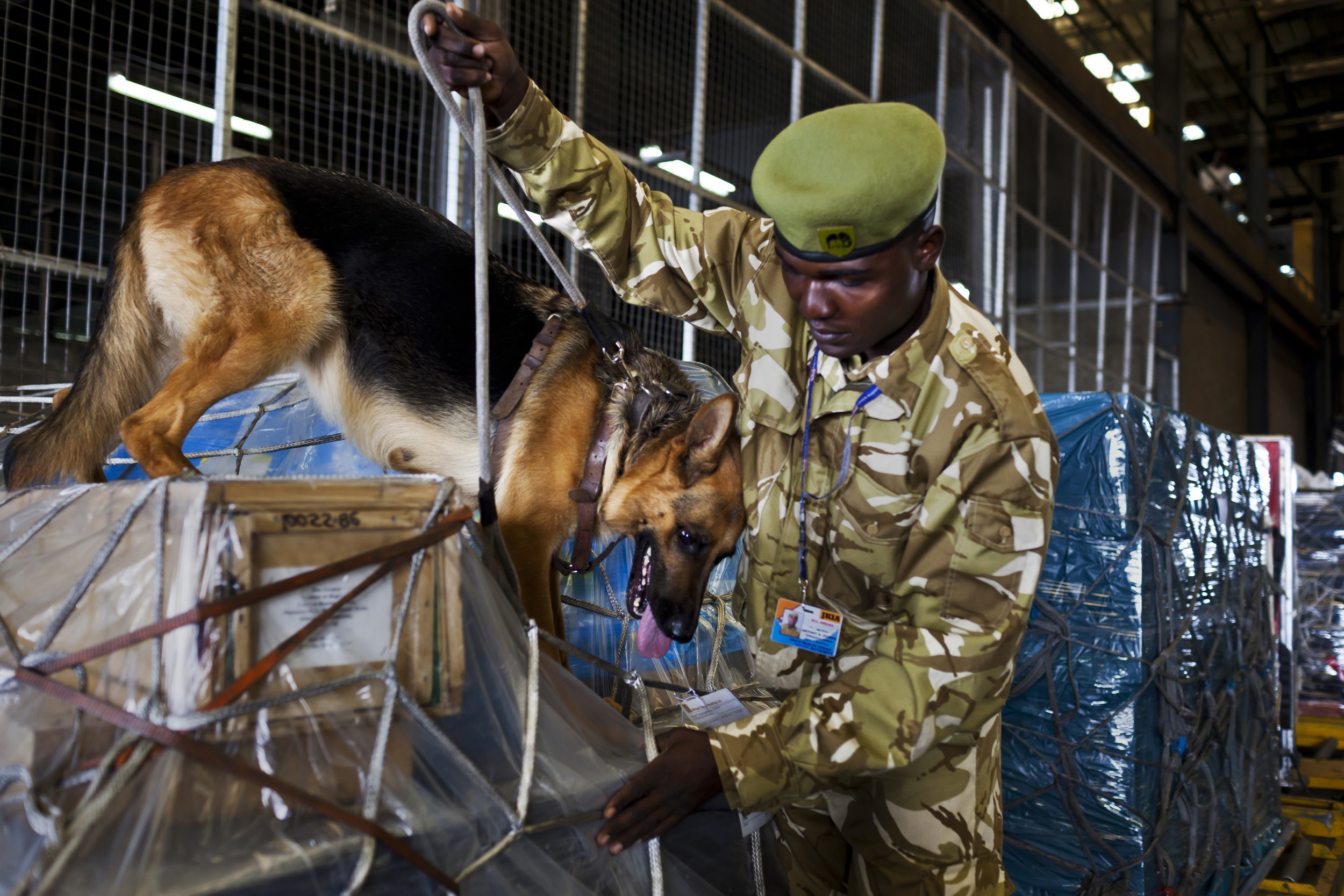
NAIROBI, KENYA, MAY 2011: Canine Handler Antony Otieno of the Kenya Wildlife Service Canine Sniffer Dog unit and his dog Tina conduct a routine search of a warehouse in Kenya's Jomo Kenyatta International Airport, Kenya, May 25 2011. Tina has been specially trained to detect ivory and the Canine unit have played a valuable role in the confiscation of over 4 tons of ivory at the airport since 2008. While the Canine Unit have had some successes, they all feel that the light penalties imposed on Ivory smugglers in Kenya make their jobs that much more difficult and would like to see harsher penalties imposed on smugglers. The current average maximum penalty for wildlife crime in Kenya is around 12000 KSH, about $150. (Photo by Brent Stirton/Reportage for National Geographic Magazine.)

NAIROBI, KENYA, JULY 2011: The personal suitcases of Chinese Nationals caught with contraband ivory seized at Jomo Kenyata International airport, Nairobi, Kenya, July 21 2011. These cases are in the contraband room at Kenya Wildlife Services HQ and are part of evidence in ongoing cases involving illegal trafficking of ivory. (Photo by Brent Stirton/Reportage for National Geographic.)

ZANZIBAR, TANZANIA, MARCH 2012: Fishermen on a traditional Dhow sail past the docks in Zanzibar, Tanzania, March 19 2012. The docks of East and Southern Africa have long formed an essential link in the smuggling of illegal Ivory from Africa to Asia. Last year in Zanzibar and Mombassa significant amounts of illegal ivory were found in containers labeled as something else on their way to the Far East. It is estimated that for every shipment found, at least another 20 make their past customs, often with the complicity of the customs authority. (Photo by Brent Stirton/Reportage for National Geographic Magazine.)

NAIROBI, KENYA, JULY 2011: A baby orphan elephant and her keeper inside her stall at the Daphne Sheldrick Elephant Orphanage in Nairobi, Kenya, July 21 2011. This orphan is the victim of a poaching incident, her mother was killed for her tusks and the baby left to fend for herself. She was fortunate enough to be recovered by the Sheldrick Conservancy and brought to the orphanage, where there are a large number of baby elephant who are similar victims of the illegal ivory trade. She will live with a dedicated keeper who functions as her parent, she spends her days with the other elephants but sleeps at night in the stall with her keeper in an extraordinary relationship which symbolises what is possible between man and animals. After a two year period she will be moved to another orphanage in Tsavo reserve and from there will be acclimatised for a move back to the bush and a natural way of life. (Photo by Brent Stirton/Reportage for National Geographic.)
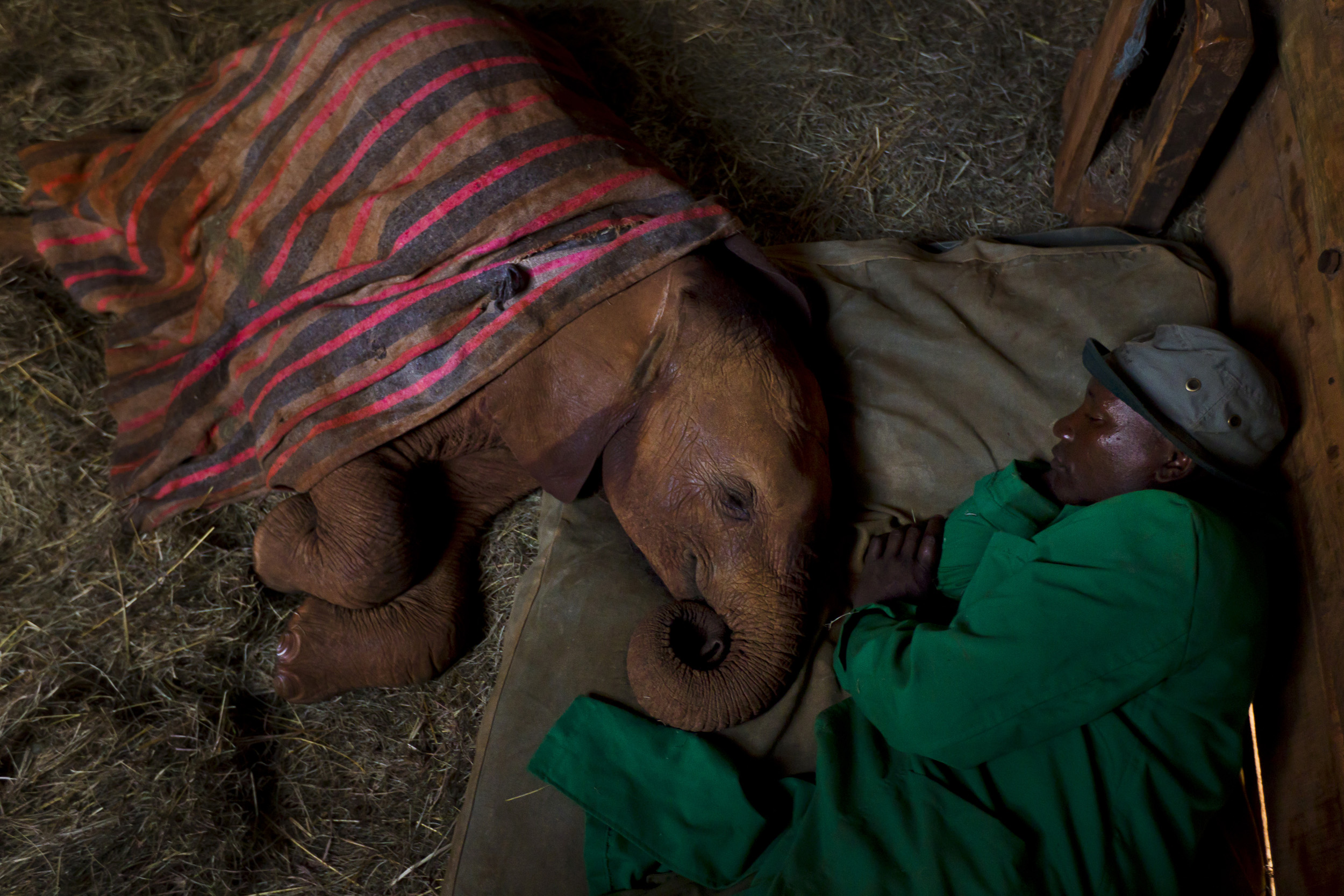
NAIROBI, KENYA, JULY 2011: A baby orphan elephant and her keeper inside her stall at the Daphne Sheldrick Elephant Orphanage in Nairobi, Kenya, July 21 2011. This orphan is the victim of a poaching incident, her mother was killed for her tusks and the baby left to fend for herself. She was fortunate enough to be recovered by the Sheldrick Conservancy and brought to the orphanage, where there are a large number of baby elephant who are similar victims of the illegal ivory trade. She will live with a dedicated keeper who functions as her parent, she spends her days with the other elephants but sleeps at night in the stall with her keeper in an extraordinary relationship which symbolises what is possible between man and animals. After a two year period she will be moved to another orphanage in Tsavo reserve and from there will be acclimatised for a move back to the bush and a natural way of life. (Photo by Brent Stirton/Reportage for National Geographic.)

BANGKOK, THAILAND, NOVEMBER 2011: Images taken at the City Pillar Shrine, Thailand, Bangkok, November 1, 2011. There are 6 elephant tusks which form part of this Shrine which was first built in 1782 and displays numerous elephant symbols in recognition of Thailand's strong legacy of the elephant. Thailand is the only country in the world to adopt the Elephant as the National symbol and place it on the flag. Thailand has a domestic elephant population, an ancient ivory carving tradition and a loophole in the law when it comes to domestic and foreign ivory. This loophole has been exploited by illegal ivory traders for a long time and there is speculation that Thailand is high on the list on transit countries for illegal ivory trafficking. (Photo by Brent Stirton/National Geographic Magazine.)

SURIN, THAILAND, NOVEMBER 2011: Images from Surin Elephant Village in Surin, Thailand, November 10th, 2011. There are over 200 elephants at this village, most of whom are used in shows which appeal to tourists. The Thai elephant used to be used in logging but this was banned in Thailand over 20 years ago due to deforestation. As a result there is a lot of pressure on Mahouts for survival and this has led to controversy in elephant matters in Thailand. The Mahouts come from a clan which has been responsible for the capture and rearing of elephants for the kings of Siam for well over a 1000 years. Their way of life is now under threat and some of the Mahouts are involved in the illegal elephant trade with Burma and also the trade in ivory and elephant parts, most of which is used in the manufacture of religious icons for the domestic trade or exported to China for foreign sales. The Thai legal system has many loopholes as a result of the domestic ivory situation and Thailand is suspected of being a major transit country for illegal African ivory as a result. (Photo by Brent Stirton/Reportage for National Geographic Magazine.)

SURIN, THAILAND, NOVEMBER 2011: Luang Poo Bru Ba Dhammamunee, head abbot of Wat Suan Paa Phutthasatharn Supraditme thee Temple, photographed with his ivory religous icons clearly visible near a ivory carving master in Surin Elephant Village in Surin, Thailand, November 9th, 2011. The monk buys his Ivory carvings of Bhudist icons for resale purposes to his followers. He commented openly on the presence in Thailand of illegally imported African ivory and advised on how to get it into Thailand past customs authorities. He also spoke of how senior memember of the Thai parliment are behind the illegal industry. He spoke enthusiastically of business opportunities if we could get him illegal African ivory, despite his public relations campaign as a carer of elephant in Thailand. The Thai legal system has many loopholes as a result of the domestic ivory situation and Thailand is suspected of being a major transit country for illegal African ivory as a result. The sale of religious ivory icons is a big part of the domestic trade while illegal ivory and elephant goods from both Thailand and Africa regularly make their way to China. (Photo by Brent Stirton/Reportage for National Geographic Magazine.)

AMPHUR NADOON, MAHASARAKHAN PROVINCE, THAILAND: Scenes from Wat suan paa Phutthasatharn Supraditme Thee temple complex, a site where elephants are being raised in controversial circumstance by Mahouts and the chief monk Luang Poo Kru Ba Dhammamunee, Amphur Nadoon, Mahasarkhan Province, Thailand, 8 November 2011. The chief monk Dhammamunee was recently accused by Thai elephant conservation groups and national media of slowly poisoning an elephant so that he could take its ivory for use in religious amulets. The monk, who has a large following, denies this and there is currently a lawsuit in the Thai courts regarding both the welfare of the elephant and defamation charges. Ivory is often used in religious artifacts and amulets in Thailand and there is some suspicion that a lot of the illegal trade in ivory is for this purpose. The Thai law also allows for a number of legal loopholes which have been exploited by Ivory traffickers, both for domestic ivory and also for illegally trafficked African ivory. (Photo by Brent Stirton/Reportage for National Geographic Magazine.)

SURIN, THAILAND, NOVEMBER 2011: Luang Poo Bru Ba Dhammamunee, head abbot of Wat Suan Paa Phutthasatharn Supraditme thee Temple, photographed in Surin Elephant Village in Surin, Thailand, November 9th, 2011. The monk buys his Ivory carvings of Bhudist icons for resale purposes to his followers. He commented openly on the presence in Thailand of illegally imported African ivory and advised on how to get it into Thailand past customs authorities. He also spoke of how senior memember of the Thai parliment are behind the illegal industry. He spoke enthusiastically of business opportunities if we could get him illegal African ivory, despite his public relations campaign as a carer of elephant in Thailand. The Thai legal system has many loopholes as a result of the domestic ivory situation and Thailand is suspected of being a major transit country for illegal African ivory as a result. The sale of religious ivory icons is a big part of the domestic trade while illegal ivory and elephant goods from both Thailand and Africa regularly make their way to China. (Photo by Brent Stirton/Reportage for National Geographic Magazine.)
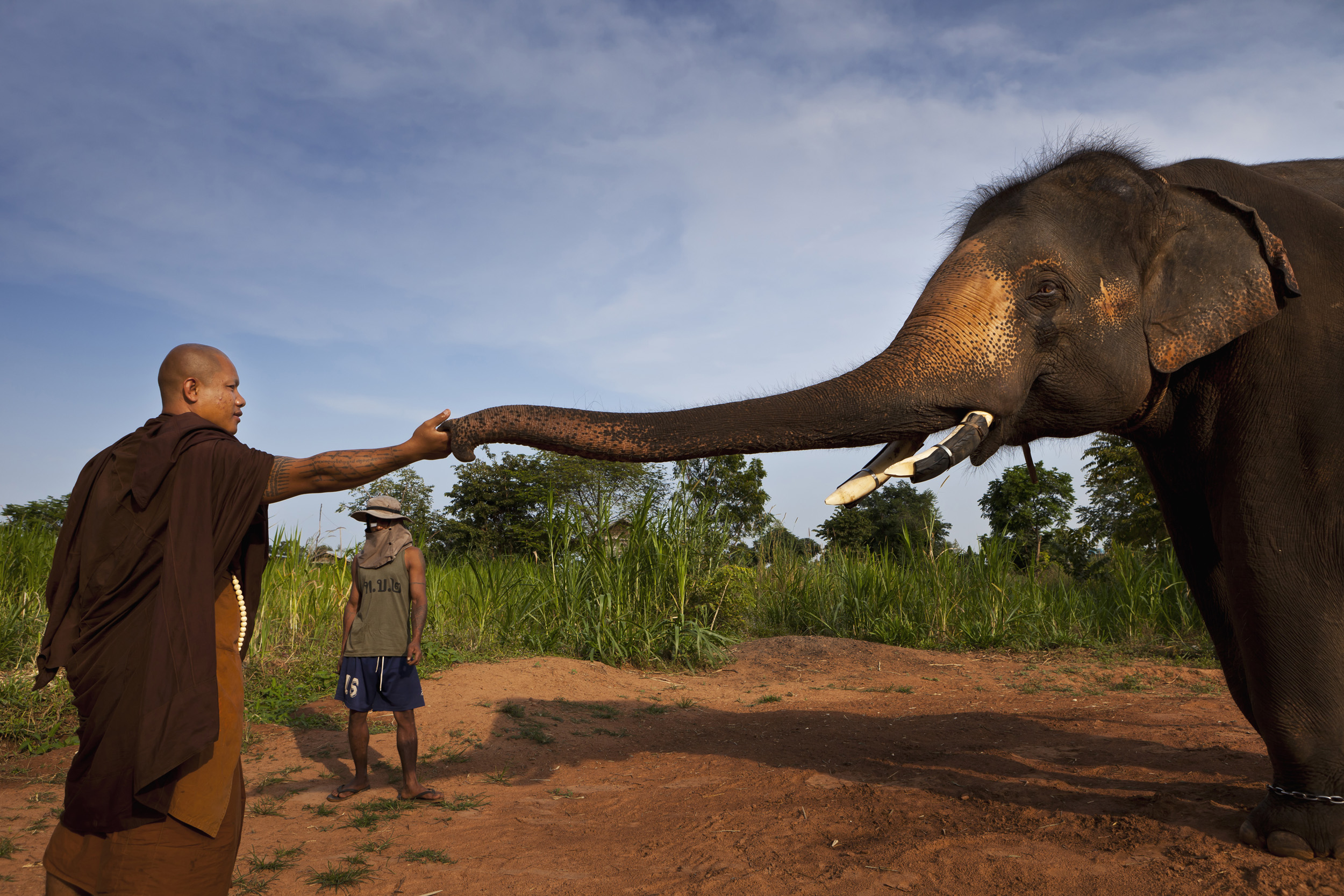
SURIN, THAILAND, NOVEMBER 2011: Luang Poo Bru Ba Dhammamunee, head abbot of Wat Suan Paa Phutthasatharn Supraditme thee Temple, photographed in Surin Elephant Village in Surin, Thailand, November 9th, 2011. The monk buys his Ivory carvings of Bhudist icons for resale purposes to his followers. He commented openly on the presence in Thailand of illegally imported African ivory and advised on how to get it into Thailand past customs authorities. He also spoke of how senior memember of the Thai parliment are behind the illegal industry. He spoke enthusiastically of business opportunities if we could get him illegal African ivory, despite his public relations campaign as a carer of elephant in Thailand. The Thai legal system has many loopholes as a result of the domestic ivory situation and Thailand is suspected of being a major transit country for illegal African ivory as a result. The sale of religious ivory icons is a big part of the domestic trade while illegal ivory and elephant goods from both Thailand and Africa regularly make their way to China. (Photo by Brent Stirton/Reportage for National Geographic Magazine.)

SURIN, THAILAND, NOVEMBER 2011: Luang Poo Bru Ba Dhammamunee, head abbot of Wat Suan Paa Phutthasatharn Supraditme thee Temple, cruises the ivory market looking for bargains in Surin Elephant Village in Surin, Thailand, November 9th, 2011. The monk buys his Ivory carvings of Bhudist icons for resale purposes to his followers. He commented openly on the presence in Thailand of illegally imported African ivory and advised on how to get it into Thailand past customs authorities. He also spoke of how senior memember of the Thai parliment are behind the illegal industry. He spoke enthusiastically of business opportunities if we could get him illegal African ivory, despite his public relations campaign as a carer of elephant in Thailand. The Thai legal system has many loopholes as a result of the domestic ivory situation and Thailand is suspected of being a major transit country for illegal African ivory as a result. The sale of religious ivory icons is a big part of the domestic trade while illegal ivory and elephant goods from both Thailand and Africa regularly make their way to China. (Photo by Brent Stirton/Reportage for National Geographic Magazine.)

SURIN, THAILAND, NOVEMBER 2011: "Jack," a Mahout at Surin Elephant Village, feeds and bathes his elephant in the early morning in a dam at Surin Elephant Village in Surin, Thailand, November 10th, 2011. "Jack" worked in China for over 13 years as an elephant Mahout. There are over 200 elephants at this village, most of whom are used in shows which appeal to tourists. The Thai elephant used to be used in logging but this was banned in Thailand over 20 years ago due to deforestation. As a result there is a lot of pressure on Mahouts for survival and this has led to controversy in elephant matters in Thailand. The Mahouts come from a clan which has been responsible for the capture and rearing of elephants for the kings of Siam for well over a 1000 years. Their way of life is now under threat and some of the Mahouts are involved in the illegal elephant trade with Burma and also the trade in ivory and elephant parts, most of which is used in the manufacture of religious icons for the domestic trade or exported to China for foreign sales. The Thai legal system has many loopholes as a result of the domestic ivory situation and Thailand is suspected of being a major transit country for illegal African ivory as a result. (Photo by Brent Stirton/Reportage for National Geographic Magazine.)

SURIN, THAILAND, NOVEMBER 2011: "Jack," a Mahout at Surin Elephant Village, feeds and bathes his elephant in the early morning in a dam at Surin Elephant Village in Surin, Thailand, November 10th, 2011. "Jack" worked in China for over 13 years as an elephant Mahout. There are over 200 elephants at this village, most of whom are used in shows which appeal to tourists. The Thai elephant used to be used in logging but this was banned in Thailand over 20 years ago due to deforestation. As a result there is a lot of pressure on Mahouts for survival and this has led to controversy in elephant matters in Thailand. The Mahouts come from a clan which has been responsible for the capture and rearing of elephants for the kings of Siam for well over a 1000 years. Their way of life is now under threat and some of the Mahouts are involved in the illegal elephant trade with Burma and also the trade in ivory and elephant parts, most of which is used in the manufacture of religious icons for the domestic trade or exported to China for foreign sales. The Thai legal system has many loopholes as a result of the domestic ivory situation and Thailand is suspected of being a major transit country for illegal African ivory as a result. (Photo by Brent Stirton/Reportage for National Geographic Magazine.)

SURIN, THAILAND, NOVEMBER 2011: "Jack," a Mahout at Surin Elephant Village, feeds and bathes his elephant in the early morning in a dam at Surin Elephant Village in Surin, Thailand, November 10th, 2011. "Jack" worked in China for over 13 years as an elephant Mahout. There are over 200 elephants at this village, most of whom are used in shows which appeal to tourists. The Thai elephant used to be used in logging but this was banned in Thailand over 20 years ago due to deforestation. As a result there is a lot of pressure on Mahouts for survival and this has led to controversy in elephant matters in Thailand. The Mahouts come from a clan which has been responsible for the capture and rearing of elephants for the kings of Siam for well over a 1000 years. Their way of life is now under threat and some of the Mahouts are involved in the illegal elephant trade with Burma and also the trade in ivory and elephant parts, most of which is used in the manufacture of religious icons for the domestic trade or exported to China for foreign sales. The Thai legal system has many loopholes as a result of the domestic ivory situation and Thailand is suspected of being a major transit country for illegal African ivory as a result. (Photo by Brent Stirton/Reportage for National Geographic Magazine.)

SURIN, THAILAND, NOVEMBER 2011: Mr Ramet Yeerum, 34, a master ivory carver at work in a small village close to Surin Elephant Village in Surin, Thailand, November 10th, 2011. Mr Yeerum stated that most of his clients are Monks who buy his Ivory carvings of Bhudist icons for resale purposes. He estimates that the vast majority of his business is the carving of these religious pieces. He commented openly on the presence in Thailand of illegally imported African ivory and how to get it into Thailand past customs authorities. He also spoke of how senior memember of the Thai parliment are behind the illegal industry. He further offered his services as a carver in Africa if we could get him there. The Thai legal system has many loopholes as a result of the domestic ivory situation and Thailand is suspected of being a major transit country for illegal African ivory as a result. (Photo by Brent Stirton/Reportage for National Geographic Magazine.)

SURIN, THAILAND, NOVEMBER 2011: Mr Ramet Yeerum, 34, a master ivory carver at work in a small village close to Surin Elephant Village in Surin, Thailand, November 10th, 2011. Mr Yeerum stated that most of his clients are Monks who buy his Ivory carvings of Bhudist icons for resale purposes. He estimates that the vast majority of his business is the carving of these religious pieces. He commented openly on the presence in Thailand of illegally imported African ivory and how to get it into Thailand past customs authorities. He also spoke of how senior memember of the Thai parliment are behind the illegal industry. He further offered his services as a carver in Africa if we could get him there. The Thai legal system has many loopholes as a result of the domestic ivory situation and Thailand is suspected of being a major transit country for illegal African ivory as a result. (Photo by Brent Stirton/Reportage for National Geographic Magazine.)

SURIN, THAILAND, NOVEMBER 2011: Luang Poo Bru Ba Dhammamunee, head abbot of Wat Suan Paa Phutthasatharn Supraditme thee Temple, walks through the elephant graveyard in Surin Elephant Village in Surin, Thailand, November 9th, 2011. The monk buys his Ivory carvings of Bhudist icons for resale purposes to his followers. He commented openly on the presence in Thailand of illegally imported African ivory and advised on how to get it into Thailand past customs authorities. He also spoke of how senior memember of the Thai parliment are behind the illegal industry. He spoke enthusiastically of business opportunities if we could get him illegal African ivory, despite his public relations campaign as a carer of elephant in Thailand. The Thai legal system has many loopholes as a result of the domestic ivory situation and Thailand is suspected of being a major transit country for illegal African ivory as a result. The sale of religious ivory icons is a big part of the domestic trade while illegal ivory and elephant goods from both Thailand and Africa regularly make their way to China. (Photo by Brent Stirton/Reportage for National Geographic Magazine.)
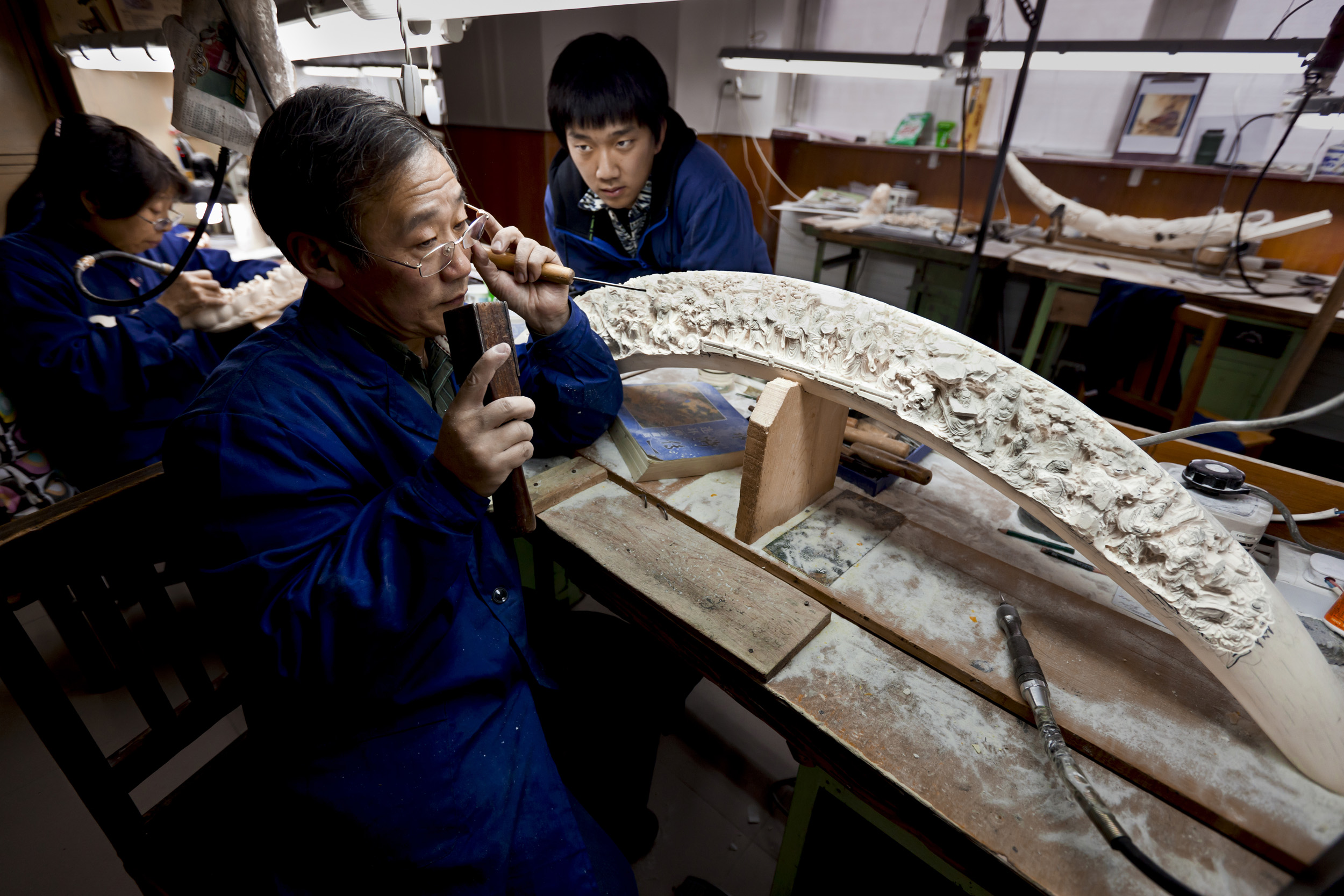
BEIJING, CHINA, NOVEMBER 2011: Images from Beijing Jin Mao Bone Carving Arts and Crafts, a 50 year old Ivory carving factory and the largest of the Chinese Ivory carving concerns, Beijing, China, November 15 2011. This company was one of only two Ivory factories in 1989, now there are 35 across China. Most of these companies exist in a state of quasi-privatisation but the government has ownership of a number. This factory has 34 carvers and claims to do over 50 big pieces every year, a big piece is the equivalent of one tusk, as well as "countless" smaller pieces. A large tusk weighs on average 20kg. This is somewhat contradictory with what they claim is their annual ivory allowance of 400kg in total. There is a great deal of illegal ivory coming into China to sate the demands of the fast rising newly wealth Chinese. There has furthermore been a crisis amongst skilled master carvers in China in that most of them are becoming older without sufficient young apprentices. In 2006 the government instituted a program for student carvers and provides subsidies for them. The master carver at this factory is Luan Yan Juao, 56, who has been carving since he was 16. He is seen working on the largest project at the factory, an exceptionally large tusk with a historic scene which is a 3 year project. It appears that China is relying publicly on a bid for new Ivory stocks every 10 years, it bought 60 tons in 2008, and officials talk about another bid soon. It is a public fact that the Chinese and Japanese delegations travelled together to the last Ivory auction, where they bid as one, enabling them to keep the price very low, around $500 a kilo. In turn they are retailing it for around $2500 a kilo, in many cases to themselves and thus quadrupling their profits pre-carving. A large tusk sells in Beijing for a million RMB, roughly $160 000. (Photo by Brent Stirton/Reportage for National Geographic Magazine.)

BEIJING, CHINA, NOVEMBER 2011: Scenes from China National Arts and Crafts Corporation - Ivory Carving factory, Beijing, China, November 17. Started in 2009 after China's big African Ivory purchase, this is supposedly the world's largest Ivory carving facility, employing more than 20 carvers and carving an alleged 750 kg of raw ivory annually. The director of the factory stated that the factory was started as a State initiative against the demise of the Ivory carving industry. State owned, it is a clear indication of the Chinese government's investment into the future of the Ivory carving trade. This factory also carves a ton of Mammoth Ivory every year. (Photo by Brent Stirton/Reportage for National Geographic Magazine.)

BEIJING, CHINA, NOVEMBER 2011: Scenes from China National Arts and Crafts Corporation - Ivory Carving factory, Beijing, China, November 17. Started in 2009 after China's big African Ivory purchase, this is supposedly the world's largest Ivory carving facility, employing more than 20 carvers and carving an alleged 750 kg of raw ivory annually. The director of the factory stated that the factory was started as a State initiative against the demise of the Ivory carving industry. State owned, it is a clear indication of the Chinese government's investment into the future of the Ivory carving trade. This factory also carves a ton of Mammoth Ivory every year. (Photo by Brent Stirton/Reportage for National Geographic Magazine.)
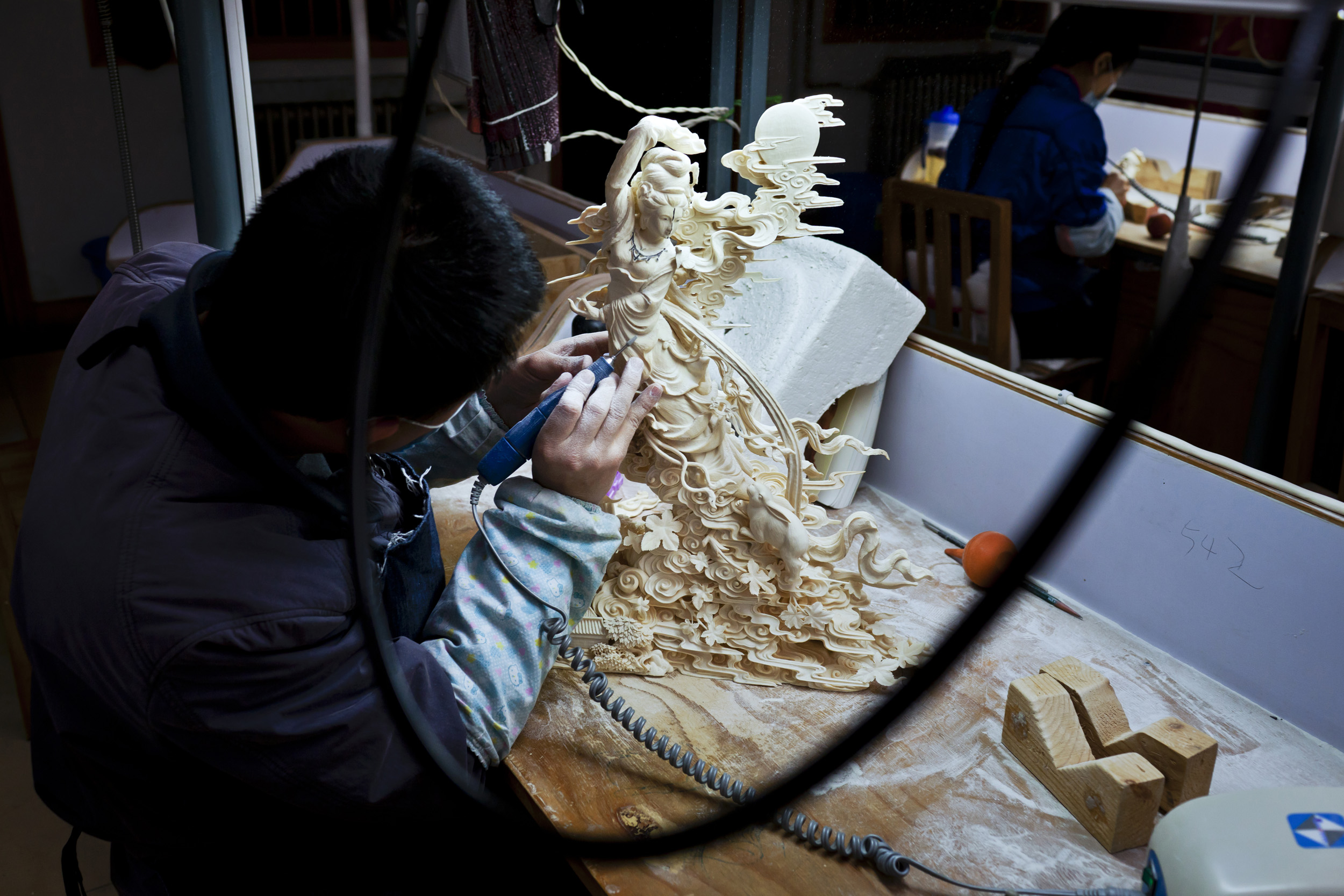
BEIJING, CHINA, NOVEMBER 2011: Scenes from China National Arts and Crafts Corporation - Ivory Carving factory, Beijing, China, November 17. Started in 2009 after China's big African Ivory purchase, this is supposedly the world's largest Ivory carving facility, employing more than 20 carvers and carving an alleged 750 kg of raw ivory annually. The director of the factory stated that the factory was started as a State initiative against the demise of the Ivory carving industry. State owned, it is a clear indication of the Chinese government's investment into the future of the Ivory carving trade. This factory also carves a ton of Mammoth Ivory every year. (Photo by Brent Stirton/Reportage for National Geographic Magazine.)
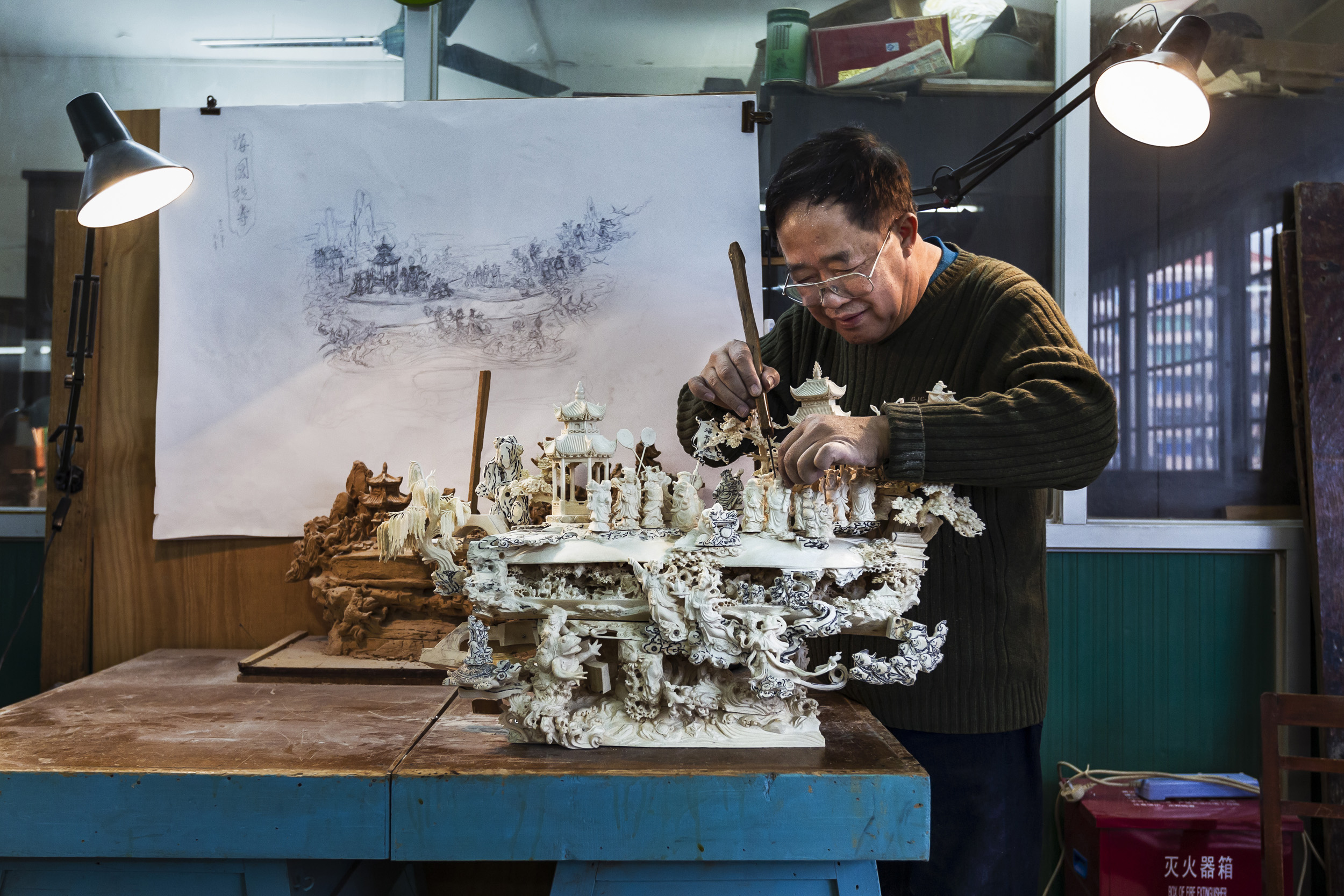
GUANGZHOU, CHINA, FEBRUARY 2012: Images of ivory carver Wu Rong Chang, 67, who has been carving for 50 years, photographed working on a large Ivory carving at the Guangzhou Daxin Ivory Carving Factory, the only state owned enterprise specialising in the ivory carving businessin the People's Republic of China, Guangzhou, February 4 2012. Daxin specialising in the Hollow Ball carving of 25 layers, large landscape ivory hillocks and also works with Mamoth Ivory. (Photo by Brent Stirton/Reportage for National Geographic Magazine.)

BEIJING, CHINA, NOVEMBER 2011: Images of Ivory on sale at government registered White Peacock Arts World, Beijing, China, November 15 2011. Exquisitely carved large pieces of appriximately one large tusk sell for an average of 1 million RMB, approximately $160 000. There has been an explosion in recent years for Ivory in China. As well as stocks purchased legally in 2008, there is a great deal of illegal ivory coming into China to sate the demands of the fast rising newly wealthy Chinese. There has furthermore been a crisis amongst skilled master carvers in China in that most of them are becoming older without sufficient young apprentices. In 2006 the government instituted a program for student carvers and provides subsidies for them. It appears that China is relying publicly on a bid for new Ivory stocks every 10 years, it bought 60 tons in 2008, and officials talk about another bid soon. The Chinese and Japanese delegations travelled together to the last Ivory auction, where they bid as one, enabling them to keep the price very low, around $500 a kilo. In turn they are retailing it for around $2500 a kilo, in many cases to themselves and thus quadrupling their profits pre-carving. A large carved tusk sells in Beijing for a million RMB, roughly $160 000. (Photo by Brent Stirton/Reportage for National Geographic Magazine.)

GUANGZHOU, CHINA, FEBRUARY 2012: Images of Ivory shoppers at the Guangzhou Daxin Ivory Carving Factory retail store, Daxin is the only state owned enterprise specialising in the ivory carving businessin the People's Republic of China, Guangzhou, February 4 2012. On this occasion a Chinese man and woman purchased 15 seperate items, spending over 100 000 RMB, over $16000. The store manager says that this is not unusual. This customer was not from Guangzhou and had come specifically to purchase Ivory for his new home and for gifts. Ivory is seen as symbol of wealth and an affirmation of prosperity amongst the Chinese. No other nation in the world has experienced such an growth of wealthy individuals as China. As a result the demand for Ivory continues apace, with potentially disastorous consequences for the elephant. (Photo by Brent Stirton/Reportage for National Geographic Magazine.)
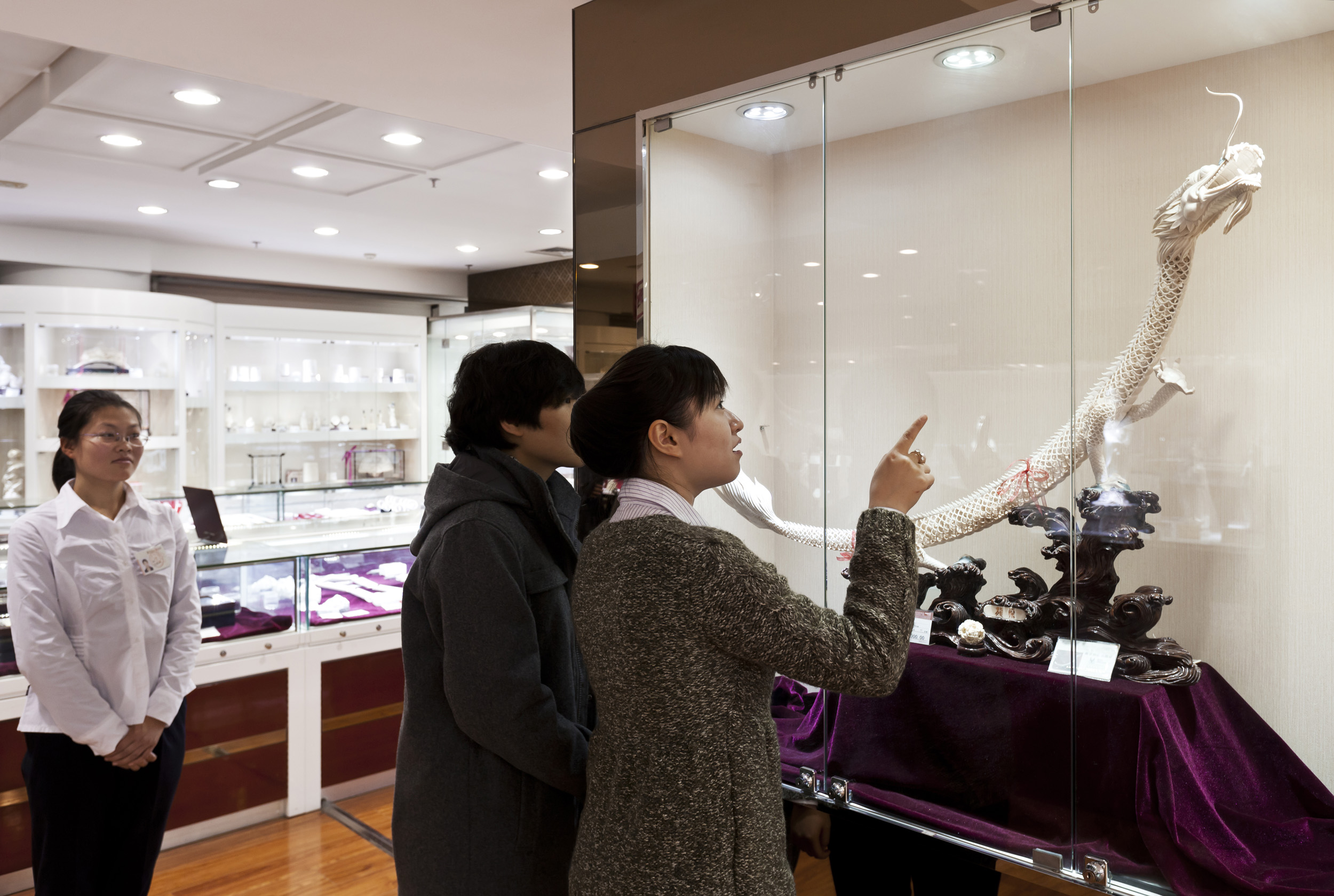
BEIJING, CHINA, NOVEMBER 2011: Ivory on sale in the Beijing Arts and Crafts Store on Wangfujing St, a popular store with an extensive selection of carved and painted Ivory on sale, Beijing, China, November 17. Certain pieces in the store sell for well over 1 million RMB, in excess of $160 000. (Photo by Brent Stirton/Reportage for National Geographic Magazine.)

GUANGZHOU, CHINA, FEBRUARY 2012: An illegal Ivory store operating in Guangzhou, China on 4 February, 2012. All Ivory sales in China are supposed to carry specific, state issued and supervised identity cards which prove the legality of the Ivory. This is supposed to prevent the use of illegally obtained, smuggled ivory in the commerical market. In this store no cards are visible whatsoever on any of more than 200 pieces. Furthermore, the woman on her phone on the right of the images is an official of the Chinese Arts and Culture institute, an official who did not notice or pay any attention to this illegality. China remains by far the world's largest consumer of Ivory, much of it coming in from smuggled sources. In the course of this investigation, we also discovered a secondary market in forged Ivory identification cards, making it easy for the unscrupulous to pass off illegal ivory as legal. (Photo by Brent Stirton/Reportage by Getty Images.)

GUANGZHOU, CHINA, FEBRUARY 2012: Gary Zeng, 42, an engineer, seen with his wife Spring Liu, 41 and their son, Andrew, inside their apartment in Guangzhou, China, February 4 2012. Zeng has just purchased two Hollow Ball ivory carvings from Daxin Ivory Carving company, one for $50 000 and the other for $70 000. He is seen unwrapping the carvings in his living room and showing them to his son, who most likely will inherit one of these in the future. The larger of the carvings is a gift Zeng bought to give to a successful entrepreneur friend of his in Shanghai. Zeng says that he bought these carvings as an investment and as a symbol of prosperity for the house he is building. He says he feels no connection to the elephant whatsoever. Zeng is typical of a new wave of wealthy Chinese who have money to spend and see Ivory as an affirmation of success, a very aspirational phenomenon in Chinese culture. Both of these carvings came with the relevant official certification. (Photo by Brent Stirton/Reportage for National Geographic Magazine.)

MANILA, PHILIPPINES, JANUARY 2012: The largest Ivory crucifix in the Philippines, located in the University of Santo Tomas Museum in Manila, Philippines, 24 January 2012. The body of Christ is carved from a single tusk and the arms were carved seperately. There is a long history of the use of Ivory in religious icons in the Philippines, this is a trend which continues today, despite the international ban on Ivory. (Photo by Brent Stirton/Reportage for National Geographic Magazine.)

CEBU, PHILIPPINES, JANUARY 2012: Religious icons in the home of a devout Filipino man who's collection is largely carved out of Ivory, Cebu, Philippines, January 19, 2012. This collection has both new and old pieces, some carved over a hundred years ago but most carved recently. The main pieces in this collection were carved within the last five to ten years. This man has extensive connections to other collectors and talks openly about the ivory trade and the "environmentalists" who are interfering with his and their collecting habits. Many of the piece in his collection are large, and would have been carved from a single large tusk. There is a collective of wealthy collectors in the Philippines who both search out and commision new work, thus sustaining a trade which allows for the continuing and growing market for new ivory. This has an inevitable effect on threatened elephant populations worldwide, accelerating demand for a commodity which is growing in value. This feature is about representing a global picture through a new and unseen lens. It places an onus of responsibility on an influential religious and wealthy elite. It offers them the chance to acknowledge their influence for good in the face of accelerating losses that are non-recoverable. It furthermore allows them to do so in the name of a value system integral to their expoused beliefs. It simply requires a reversal of priorities, from one that places iconography above life, to one that places life about iconography. This preaches a new message of compassion for all life, all God’s life, and ultimately benefits the protagonists and allows them to emerge not only unscathed but reinvigorates their standing as leaders in the value system their religious sector expouses. (Photo by Brent Stirton/Reportage for National Geographic.)

CEBU, PHILIPPINES, JANUARY 2012: Religious icons in the home of a devout Filipino man who's collection is largely carved out of Ivory, Cebu, Philippines, January 19, 2012. This collection has both new and old pieces, some carved over a hundred years ago but most carved recently. The main pieces in this collection were carved within the last five to ten years. This man has extensive connections to other collectors and talks openly about the ivory trade and the "environmentalists" who are interfering with his and their collecting habits. Many of the piece in his collection are large, and would have been carved from a single large tusk. There is a collective of wealthy collectors in the Philippines who both search out and commision new work, thus sustaining a trade which allows for the continuing and growing market for new ivory. This has an inevitable effect on threatened elephant populations worldwide, accelerating demand for a commodity which is growing in value. This feature is about representing a global picture through a new and unseen lens. It places an onus of responsibility on an influential religious and wealthy elite. It offers them the chance to acknowledge their influence for good in the face of accelerating losses that are non-recoverable. It furthermore allows them to do so in the name of a value system integral to their expoused beliefs. It simply requires a reversal of priorities, from one that places iconography above life, to one that places life about iconography. This preaches a new message of compassion for all life, all God’s life, and ultimately benefits the protagonists and allows them to emerge not only unscathed but reinvigorates their standing as leaders in the value system their religious sector expouses. (Photo by Brent Stirton/Reportage for National Geographic.)

CEBU, PHILIPPINES, JANUARY 2012: Devotees touch and kiss the glass housing an Ivory icon Our Lady of Manaoag in St Joseph's Cathedral, Cebu, Philippines, 13 January 2012. This devotional is part of the Sinulog festival, a larger celebration devoted to the Santo Nino, a 15th century religious icon portraying Jesus Christ as an infant, originally brought to Cebu by Ferdinand Maggelan in 1521. Historical accounts say that before Portuguese navigator Ferdinand Magellan came to Cebu on April 7, 1521 to plant the cross on its shore and claim the country for the King of Spain, Sinulog was already danced by the natives in honor of their wooden idols and anitos. Then Magellan came and introduced Christianity. He gave the Santo Nino (image of the Child Jesus) as baptismal gift to Hara Amihan, wife of Cebu’s Rajah Humabon who was later named Queen Juana. At that time, not only the rulers were baptized but also about 800 of their subjects. Unfortunately, however, shortly after the conversion, Magellan went into a reckless adventure by fighting the reigning ruler of Mactan, Rajah Lapulapu, with only a handful of men. He died in the encounter. That was on April 27, 1521. The remnants of Magellan’s men were able to return to Spain to report the incident and the possibility of conquest. It took 44 years before a new group came and started the formal Christianization of the islands. Miguel Lopez de Legaspi arrived in Cebu on April 28, 1565. His ships bombarded the village and in one of the burning huts, one of his soldiers named Juan Camus found inside a wooden box the image of the Santo Nino lying side by side with native idols. Historians now say that during the 44 years between the coming of Magellan and Legaspi, the natives continued to dance the Sinulog. This time however, they danced it no longer to worship their native idols but a sign of reverence to the Santo Nino which is now enshrined at the San Agustin Church ( renamed Basilica Minore del Santo Nino). The Santo Nino

CEBU, PHILIPPINES, JANUARY 2012: Devotees touch and kiss the glass housing an Ivory icon Our Lady of Manaoag in St Joseph's Cathedral, Cebu, Philippines, 13 January 2012. This devotional is part of the Sinulog festival, a larger celebration devoted to the Santo Nino, a 15th century religious icon portraying Jesus Christ as an infant, originally brought to Cebu by Ferdinand Maggelan in 1521. Historical accounts say that before Portuguese navigator Ferdinand Magellan came to Cebu on April 7, 1521 to plant the cross on its shore and claim the country for the King of Spain, Sinulog was already danced by the natives in honor of their wooden idols and anitos. Then Magellan came and introduced Christianity. He gave the Santo Nino (image of the Child Jesus) as baptismal gift to Hara Amihan, wife of Cebu’s Rajah Humabon who was later named Queen Juana. At that time, not only the rulers were baptized but also about 800 of their subjects. Unfortunately, however, shortly after the conversion, Magellan went into a reckless adventure by fighting the reigning ruler of Mactan, Rajah Lapulapu, with only a handful of men. He died in the encounter. That was on April 27, 1521. The remnants of Magellan’s men were able to return to Spain to report the incident and the possibility of conquest. It took 44 years before a new group came and started the formal Christianization of the islands. Miguel Lopez de Legaspi arrived in Cebu on April 28, 1565. His ships bombarded the village and in one of the burning huts, one of his soldiers named Juan Camus found inside a wooden box the image of the Santo Nino lying side by side with native idols. Historians now say that during the 44 years between the coming of Magellan and Legaspi, the natives continued to dance the Sinulog. This time however, they danced it no longer to worship their native idols but a sign of reverence to the Santo Nino which is now enshrined at the San Agustin Church ( renamed Basilica Minore del Santo Nino). The Santo Nino

CEBU, PHILIPPINES, JANUARY 2012: The "Walk with Mary," procession in Cebu, Philippines, 13 January 2012. The "Mary" seen on the float is Our Lady of Guidance, traditionally housed in the Basilica Minore del Santo Nino in Cebu city and she is made of Ivory. This substance has long been used in religious circles for statues and carvings of important icons across all the major religions in a practise that continues today. This devotional walk is part of the Sinulog festival, a larger celebration largely devoted to the Santo Nino, a 15th century religious icon portraying Jesus Christ as an infant, originally brought to Cebu by Ferdinand Maggelan in 1521. There are a large number of Ivory carved Santo Nino's in existence too. Many are owned by private collectors who collect them with some fervour, others are housed behind glass in churches where devotees will often touch the glass or rub material on the glas in order to receive the blessing of the Icon. Ivory has long been a high end material for the creation of these religious pieces. Historical accounts say that before Portuguese navigator Ferdinand Magellan came to Cebu on April 7, 1521 to plant the cross on its shore and claim the country for the King of Spain, Sinulog was already danced by the natives in honor of their wooden idols and anitos. Then Magellan came and introduced Christianity. He gave the Santo Nino (image of the Child Jesus) as baptismal gift to Hara Amihan, wife of Cebu’s Rajah Humabon who was later named Queen Juana. At that time, not only the rulers were baptized but also about 800 of their subjects. Unfortunately, however, shortly after the conversion, Magellan went into a reckless adventure by fighting the reigning ruler of Mactan, Rajah Lapulapu, with only a handful of men. He died in the encounter. That was on April 27, 1521. The remnants of Magellan’s men were able to return to Spain to report the incident and the possibility of conquest. It took 44 years before a new group came and starte

CEBU, PHILIPPINES, JANUARY 2012: The "Walk with Mary," procession in Cebu, Philippines, 13 January 2012. The "Mary" seen on the float is Our Lady of Guidance, traditionally housed in the Basilica Minore del Santo Nino in Cebu city and she is made of Ivory. This substance has long been used in religious circles for statues and carvings of important icons across all the major religions in a practise that continues today. This devotional walk is part of the Sinulog festival, a larger celebration largely devoted to the Santo Nino, a 15th century religious icon portraying Jesus Christ as an infant, originally brought to Cebu by Ferdinand Maggelan in 1521. There are a large number of Ivory carved Santo Nino's in existence too. Many are owned by private collectors who collect them with some fervour, others are housed behind glass in churches where devotees will often touch the glass or rub material on the glas in order to receive the blessing of the Icon. Ivory has long been a high end material for the creation of these religious pieces. Historical accounts say that before Portuguese navigator Ferdinand Magellan came to Cebu on April 7, 1521 to plant the cross on its shore and claim the country for the King of Spain, Sinulog was already danced by the natives in honor of their wooden idols and anitos. Then Magellan came and introduced Christianity. He gave the Santo Nino (image of the Child Jesus) as baptismal gift to Hara Amihan, wife of Cebu’s Rajah Humabon who was later named Queen Juana. At that time, not only the rulers were baptized but also about 800 of their subjects. Unfortunately, however, shortly after the conversion, Magellan went into a reckless adventure by fighting the reigning ruler of Mactan, Rajah Lapulapu, with only a handful of men. He died in the encounter. That was on April 27, 1521. The remnants of Magellan’s men were able to return to Spain to report the incident and the possibility of conquest. It took 44 years before a new group came and starte

CEBU, PHILIPPINES, JANUARY 2012: Armed security guards watch over an ivory carved St Joseph statue on display at a religious exhibit in Park Mall shopping center, Cebu, Philippines, January 19, 2012. There is a space to pray in front of the statue and there are also many other smaller icons on display. This is the largest Ivory carved statue of St Joseph in existence. There is a collective of wealthy collectors in the Philippines who both search out and commision new work, thus sustaining a trade which allows for the continuing and growing market for new ivory. This has an inevitable effect on threatened elephant populations worldwide, accelerating demand for a commodity which is growing in value. This feature is about representing a global picture through a new and unseen lens. It places an onus of responsibility on an influential religious and wealthy elite. It offers them the chance to acknowledge their influence for good in the face of accelerating losses that are non-recoverable. It furthermore allows them to do so in the name of a value system integral to their expoused beliefs. It simply requires a reversal of priorities, from one that places iconography above life, to one that places life about iconography. This preaches a new message of compassion for all life, all God’s life, and ultimately benefits the protagonists and allows them to emerge not only unscathed but reinvigorates their standing as leaders in the value system their religious sector expouses. (Photo by Brent Stirton/Reportage for National Geographic.)

MALOLOS, PHILIPPINES, JANUARY 2012: Dez Battista, an expert on religious icons in the Philippines, prepares his " Nuestra Senora Reina del Ciela," (Our Lady of Heaven," for a religious procession in the streets of Malolos, the birthplace of the Santo Nino phenomenon in the Philippines, January 28 2012. The Icon has head and hands made of solid Ivory, these pieces were comissioned by Mr Battista 15 years ago. This is post Ban Ivory and it is unknown whether this work is made from illegal ivory, of which there is a great deal in the Philippines, mostly used for the carving of religious iconography. The procession will feature 200 similar icons, many of which are made of Ivory. (Photo by Brent Stirton/Reportage by National Geographic.)

MALOLOS, PHILIPPINES, JANUARY 2012: Dez Battista, an expert on religious icons in the Philippines, prepares his " Nuestra Senora Reina del Ciela," (Our Lady of Heaven," for a religious procession in the streets of Malolos, the birthplace of the Santo Nino phenomenon in the Philippines, January 28 2012. The Icon has head and hands made of solid Ivory, these pieces were comissioned by Mr Battista 15 years ago. This is post Ban Ivory and it is unknown whether this work is made from illegal ivory, of which there is a great deal in the Philippines, mostly used for the carving of religious iconography. The procession will feature 200 similar icons, many of which are made of Ivory. (Photo by Brent Stirton/Reportage by National Geographic.)

VALENZULEA, PHILIPPINES, JANUARY 2012: Master sculptor Marcial Bernales carves an Ivory head and hand set for a Catholic religious icon in his worshop in Valenzulea, close to Manila, Philippines, 25 January 2012. Bernales has been carving Ivory for 45 years and has made hundreds of pieces, all of which are of a religious nature in the Catholic faith in the Philippines. Many of these pieces are made with Ivory. His work is in the collections of many devotees and his ivory pieces are in great demand amongst the wealthy collectors of the Philippines. His workshop and workload are co-run by his wife Nene, who also runs his shop in Manila. She is a long running expert in the garments that clothe these religious icons. Their brisk trade is evidence of the demand for Ivory, they claims to use only pre-ban ivory but that is questionable given the attraction of price for ivory at 20000 pesos ($500) a kilo for raw ivory and far more for carved Benales masterpieces. It also illustrates the loophole in Ivory legislation whereby it is very difficult to tell pre-ban and post ban ivory apart. Once it is in the Philippines there are no records or statistics through which to verify claims, despite the fact that this is a centre for world ivory carving. (photo by Brent Stirton/Reportage for National Geographic Magazine.)

VALENZULEA, PHILIPPINES, JANUARY 2012: Master sculptor Marcial Bernales carves an Ivory head and hand set for a Catholic religious icon in his worshop in Valenzulea, close to Manila, Philippines, 25 January 2012. Bernales has been carving Ivory for 45 years and has made hundreds of pieces, all of which are of a religious nature in the Catholic faith in the Philippines. Many of these pieces are made with Ivory. His work is in the collections of many devotees and his ivory pieces are in great demand amongst the wealthy collectors of the Philippines. His workshop and workload are co-run by his wife Nene, who also runs his shop in Manila. She is a long running expert in the garments that clothe these religious icons. Their brisk trade is evidence of the demand for Ivory, they claims to use only pre-ban ivory but that is questionable given the attraction of price for ivory at 20000 pesos ($500) a kilo for raw ivory and far more for carved Benales masterpieces. It also illustrates the loophole in Ivory legislation whereby it is very difficult to tell pre-ban and post ban ivory apart. Once it is in the Philippines there are no records or statistics through which to verify claims, despite the fact that this is a centre for world ivory carving. (photo by Brent Stirton/Reportage for National Geographic Magazine.)

VALENZULEA, PHILIPPINES, JANUARY 2012: Master sculptor Marcial Bernales carves an Ivory head and hand set for a Catholic religious icon in his worshop in Valenzulea, close to Manila, Philippines, 25 January 2012. Bernales has been carving Ivory for 45 years and has made hundreds of pieces, all of which are of a religious nature in the Catholic faith in the Philippines. Many of these pieces are made with Ivory. His work is in the collections of many devotees and his ivory pieces are in great demand amongst the wealthy collectors of the Philippines. His workshop and workload are co-run by his wife Nene, who also runs his shop in Manila. She is a long running expert in the garments that clothe these religious icons. Their brisk trade is evidence of the demand for Ivory, they claims to use only pre-ban ivory but that is questionable given the attraction of price for ivory at 20000 pesos ($500) a kilo for raw ivory and far more for carved Benales masterpieces. It also illustrates the loophole in Ivory legislation whereby it is very difficult to tell pre-ban and post ban ivory apart. Once it is in the Philippines there are no records or statistics through which to verify claims, despite the fact that this is a centre for world ivory carving. (photo by Brent Stirton/Reportage for National Geographic Magazine.)

VALENZULEA, PHILIPPINES, JANUARY 2012: Master seamstress Nene Bernale displays a large cloak embroidered for a large Catholic religious icon in the worshop in Valenzulea, close to Manila, Philippines, 25 January 2012. Nene's husband Marcial Bernales has been carving Ivory for 45 years and has made hundreds of pieces, all of which are of a religious nature in the Catholic faith in the Philippines. Many of these pieces are made with Ivory. His work is in the collections of many devotees and his ivory pieces are in great demand amongst the wealthy collectors of the Philippines. His workshop and workload are co-run by his wife Nene, who also runs his shop in Manila. She is a long running expert in the garments that clothe these religious icons. Their brisk trade is evidence of the demand for Ivory, they claims to use only pre-ban ivory but that is questionable given the attraction of price for ivory at 20000 pesos ($500) a kilo for raw ivory and far more for carved Benales masterpieces. It also illustrates the loophole in Ivory legislation whereby it is very difficult to tell pre-ban and post ban ivory apart. Once it is in the Philippines there are no records or statistics through which to verify claims, despite the fact that this is a centre for world ivory carving. (photo by Brent Stirton/Reportage for National Geographic Magazine.)

VALENZULEA, PHILIPPINES, JANUARY 2012: Master sculptor Marcial Bernales's production schedule board for the carving of Catholic religious icons in his worshop in Valenzulea, close to Manila, Philippines, 25 January 2012. Bernales has been carving Ivory for 45 years and has made hundreds of pieces, all of which are of a religious nature in the Catholic faith in the Philippines. Many of these pieces are made with Ivory. His work is in the collections of many devotees and his ivory pieces are in great demand amongst the wealthy collectors of the Philippines. His workshop and workload are co-run by his wife Nene, who also runs his shop in Manila. She is a long running expert in the garments that clothe these religious icons. Their brisk trade is evidence of the demand for Ivory, they claims to use only pre-ban ivory but that is questionable given the attraction of price for ivory at 20000 pesos ($500) a kilo for raw ivory and far more for carved Benales masterpieces. It also illustrates the loophole in Ivory legislation whereby it is very difficult to tell pre-ban and post ban ivory apart. Once it is in the Philippines there are no records or statistics through which to verify claims, despite the fact that this is a centre for world ivory carving. (photo by Brent Stirton/Reportage for National Geographic Magazine.)
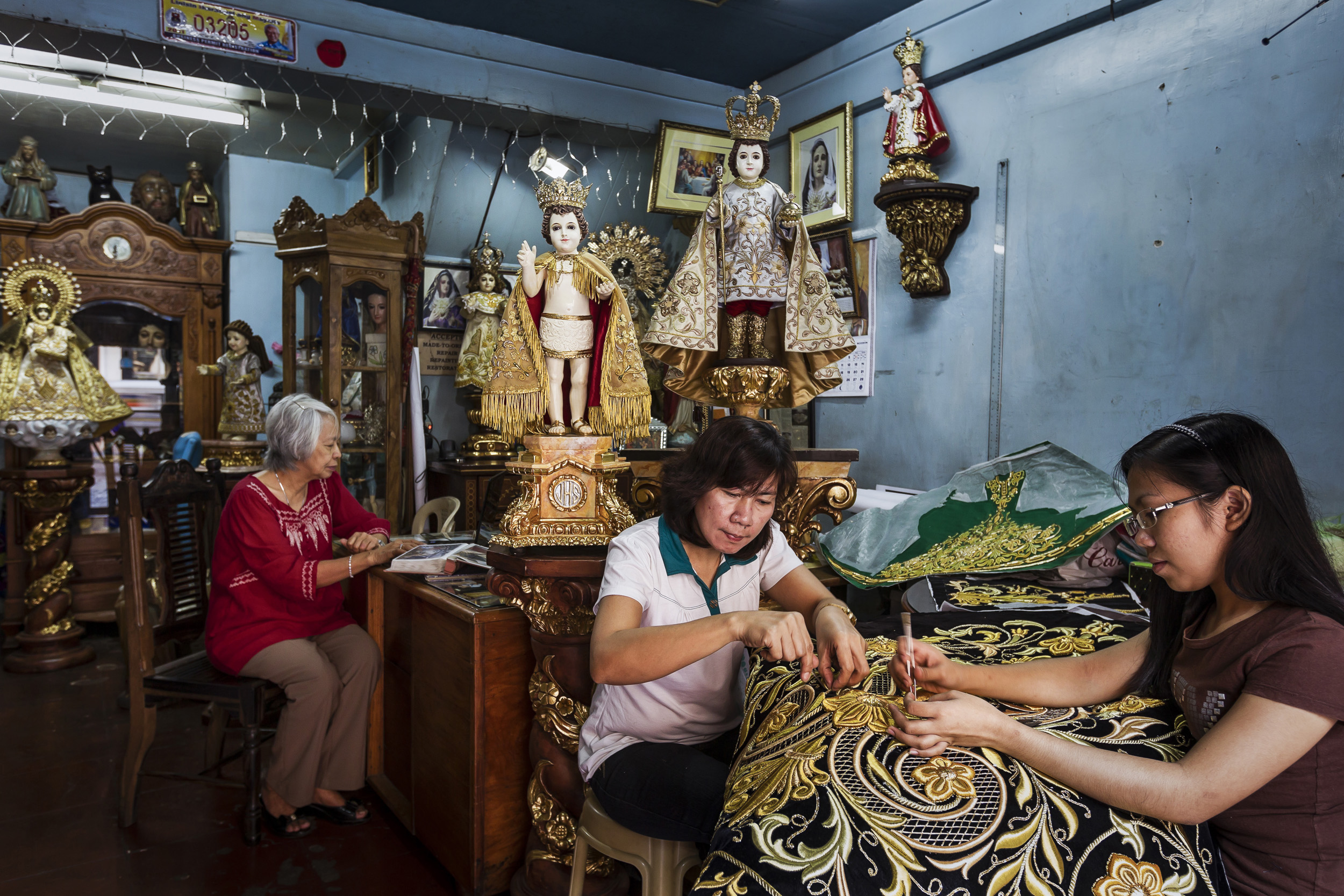
MANILA, PHILIPPINES, JANUARY 2012: Catholic icon dealer Nene Bernales and embroidery staff at work in her shop in Manila, Philippines, 25 January 2012. They are surrounded by Icons that have heads and hands made of Ivory. Nene's husband Marcial Bernales has been carving Ivory for 45 years and has made hundreds of pieces, all of which are of a religious nature in the Catholic faith in the Philippines. His work is in the collections of many devotees and his ivory pieces are in great demand amongst the wealthy collectors of the Philippines. His workshop and store are co-run by his wife Nene. She is a long time expert in the garments that clothe these religious icons. The brisk trade and high demand for Ivory icons is evidence of the demand for Ivory, the Bernale's claim to use only pre-ban ivory but that is questionable given the attraction of the very high prices paid for carved Benales masterpieces. There is not sufficent pre-ban supply to fullfill demand for these pieces in the Philippines. The Icon trade also further illuminates the loophole in Ivory legislation whereby it is very difficult to tell pre-ban and post ban ivory apart. Once raw ivory tusks are in the Philippines, there are no records or statistics through which to verify claims of legal ownership or criminality, despite the fact that this is a centre for world ivory carving. (photo by Brent Stirton/Reportage for National Geographic Magazine.)
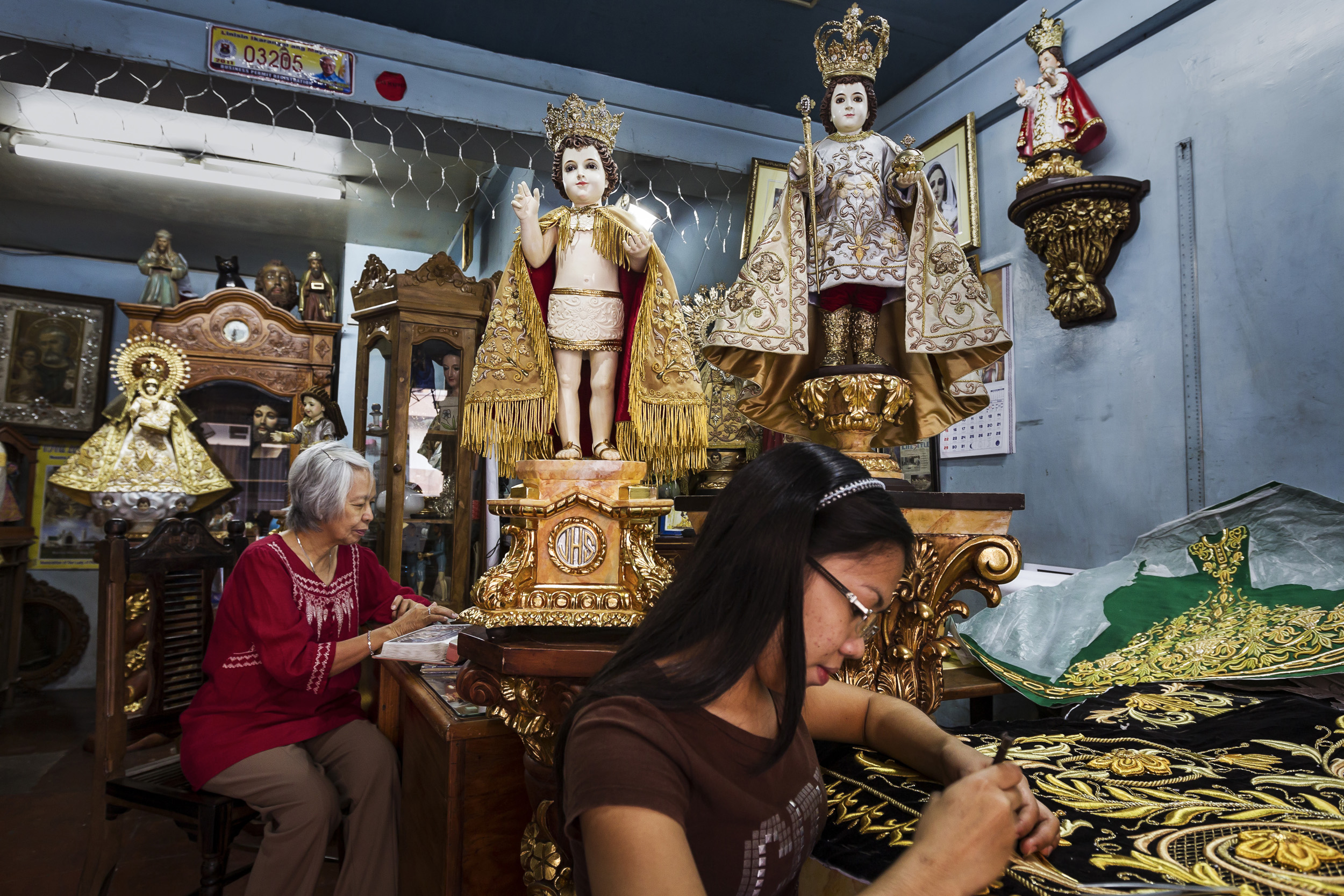
MANILA, PHILIPPINES, JANUARY 2012: Catholic icon dealer Nene Bernales and embroidery staff at work in her shop in Manila, Philippines, 25 January 2012. They are surrounded by Icons that have heads and hands made of Ivory. Nene's husband Marcial Bernales has been carving Ivory for 45 years and has made hundreds of pieces, all of which are of a religious nature in the Catholic faith in the Philippines. His work is in the collections of many devotees and his ivory pieces are in great demand amongst the wealthy collectors of the Philippines. His workshop and store are co-run by his wife Nene. She is a long time expert in the garments that clothe these religious icons. The brisk trade and high demand for Ivory icons is evidence of the demand for Ivory, the Bernale's claim to use only pre-ban ivory but that is questionable given the attraction of the very high prices paid for carved Benales masterpieces. There is not sufficent pre-ban supply to fullfill demand for these pieces in the Philippines. The Icon trade also further illuminates the loophole in Ivory legislation whereby it is very difficult to tell pre-ban and post ban ivory apart. Once raw ivory tusks are in the Philippines, there are no records or statistics through which to verify claims of legal ownership or criminality, despite the fact that this is a centre for world ivory carving. (photo by Brent Stirton/Reportage for National Geographic Magazine.)
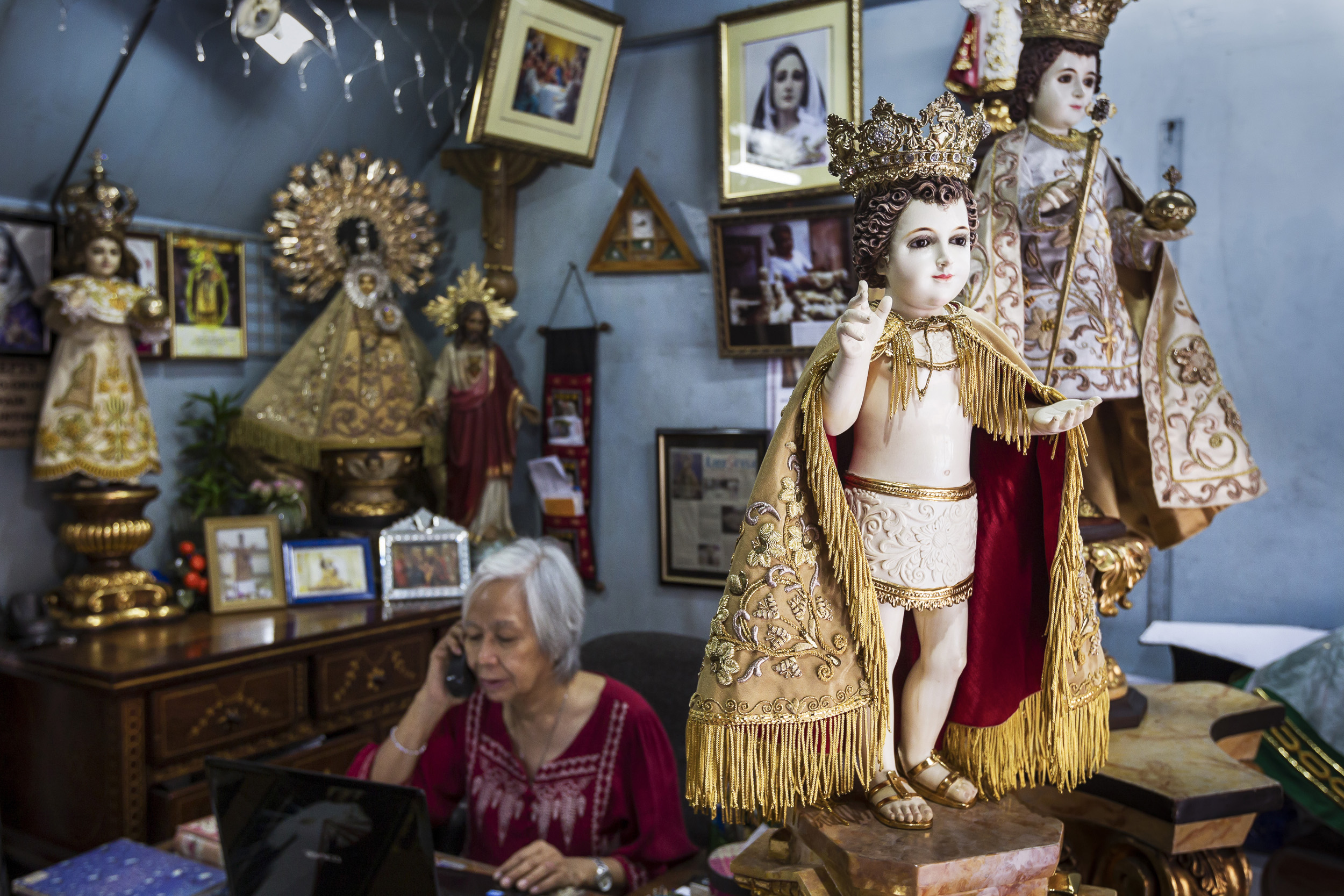
MANILA, PHILIPPINES, JANUARY 2012: Catholic icon dealer Nene Bernales and embroidery staff at work in her shop in Manila, Philippines, 25 January 2012. They are surrounded by Icons that have heads and hands made of Ivory. Nene's husband Marcial Bernales has been carving Ivory for 45 years and has made hundreds of pieces, all of which are of a religious nature in the Catholic faith in the Philippines. His work is in the collections of many devotees and his ivory pieces are in great demand amongst the wealthy collectors of the Philippines. His workshop and store are co-run by his wife Nene. She is a long time expert in the garments that clothe these religious icons. The brisk trade and high demand for Ivory icons is evidence of the demand for Ivory, the Bernale's claim to use only pre-ban ivory but that is questionable given the attraction of the very high prices paid for carved Benales masterpieces. There is not sufficent pre-ban supply to fullfill demand for these pieces in the Philippines. The Icon trade also further illuminates the loophole in Ivory legislation whereby it is very difficult to tell pre-ban and post ban ivory apart. Once raw ivory tusks are in the Philippines, there are no records or statistics through which to verify claims of legal ownership or criminality, despite the fact that this is a centre for world ivory carving. (photo by Brent Stirton/Reportage for National Geographic Magazine.)

MALOLOS, PHILIPPINES, JANUARY 2012: Over 200 hundred Santo Nino Coronas housing Santo Nino icons wait in Malolos Basilica for a religious procession in the streets of Malolos, the birthplace of the Santo Nino phenomenon in the Philippines, January 28 2012. Many of these icons have heads and hands made of solid Ivory, many of these pieces are made recently, in the post Ivory ban period. It is very difficult to tell whether this work is made from illegal ivory, of which there is a great deal in the Philippines, mostly used for the carving of religious iconography. What is for certain is that there is a thriving trade in the ivory carving for religious icon purposes. The Philippines has no elephant population but is one of the largest users of Ivory. (Photo by Brent Stirton/Reportage by National Geographic.)
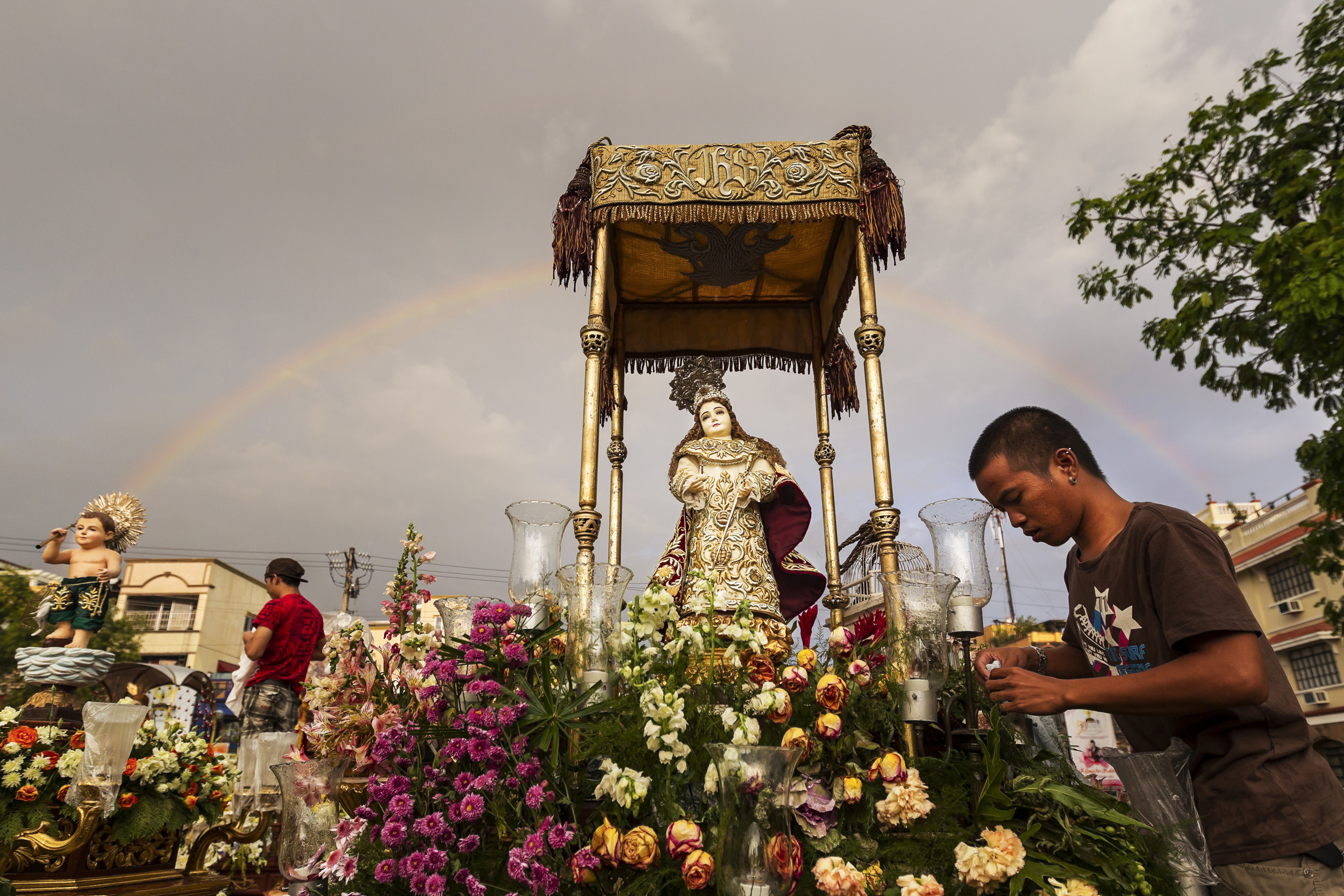
MALOLOS, PHILIPPINES, JANUARY 2012: Over 200 hundred Santo Nino Coronas housing Santo Nino icons wait in Malolos Basilica for a religious procession in the streets of Malolos, the birthplace of the Santo Nino phenomenon in the Philippines, January 28 2012. Many of these icons have heads and hands made of solid Ivory, many of these pieces are made recently, in the post Ivory ban period. It is very difficult to tell whether this work is made from illegal ivory, of which there is a great deal in the Philippines, mostly used for the carving of religious iconography. What is for certain is that there is a thriving trade in the ivory carving for religious icon purposes. The Philippines has no elephant population but is one of the largest users of Ivory. (Photo by Brent Stirton/Reportage by National Geographic.)

CEBU, PHILIPPINES, JANUARY 2012: A wealthy, devout Filipino man amongst his religious icon collection which is largely carved out of Ivory, Cebu, Philippines, January 19, 2012. This collection has both new and old pieces, most carved within the last 5 years. There is a collective of wealthy collectors in the Philippines who both search out and commision new work, thus sustaining a trade which allows for the continuing and growing market for new ivory. This has an inevitable effect on threatened elephant populations worldwide, accelerating demand for a commodity which is growing in value. This feature is about representing a global picture through a new and unseen lens. It places an onus of responsibility on an influential religious and wealthy elite. It offers them the chance to acknowledge their influence for good in the face of accelerating losses that are non-recoverable. It furthermore allows them to do so in the name of a value system integral to their expoused beliefs. It simply requires a reversal of priorities, from one that places iconography above life, to one that places life about iconography. This preaches a new message of compassion for all life, all God’s life, and ultimately benefits the protagonists and allows them to emerge not only unscathed but reinvigorates their standing as leaders in the value system their religious sector expouses. (Photo by Brent Stirton/Reportage for National Geographic.)

CEBU, PHILIPPINES, JANUARY 2012: A wealthy, devout Filipino man amongst his religious icon collection which is largely carved out of Ivory, Cebu, Philippines, January 19, 2012. This collection has both new and old pieces, most carved within the last 5 years. There is a collective of wealthy collectors in the Philippines who both search out and commision new work, thus sustaining a trade which allows for the continuing and growing market for new ivory. This has an inevitable effect on threatened elephant populations worldwide, accelerating demand for a commodity which is growing in value. This feature is about representing a global picture through a new and unseen lens. It places an onus of responsibility on an influential religious and wealthy elite. It offers them the chance to acknowledge their influence for good in the face of accelerating losses that are non-recoverable. It furthermore allows them to do so in the name of a value system integral to their expoused beliefs. It simply requires a reversal of priorities, from one that places iconography above life, to one that places life about iconography. This preaches a new message of compassion for all life, all God’s life, and ultimately benefits the protagonists and allows them to emerge not only unscathed but reinvigorates their standing as leaders in the value system their religious sector expouses. (Photo by Brent Stirton/Reportage for National Geographic.)

CEBU, PHILIPPINES, JANUARY 2012: A wealthy, young and devout Filipino man prays in front of his religious icon collection which is carved out of Ivory, Cebu, Philippines, January 19, 2012. The man prays before this icon before he leaves his house every day. His collection has both new and old pieces, most carved within the last 5 years. There is a collective of wealthy collectors in the Philippines who both search out and commision new work, thus sustaining a trade which allows for the continuing and growing market for new ivory. This has an inevitable effect on threatened elephant populations worldwide, accelerating demand for a commodity which is growing in value. This feature is about representing a global picture through a new and unseen lens. It places an onus of responsibility on an influential religious and wealthy elite. It offers them the chance to acknowledge their influence for good in the face of accelerating losses that are non-recoverable. It furthermore allows them to do so in the name of a value system integral to their expoused beliefs. It simply requires a reversal of priorities, from one that places iconography above life, to one that places life about iconography. This preaches a new message of compassion for all life, all God’s life, and ultimately benefits the protagonists and allows them to emerge not only unscathed but reinvigorates their standing as leaders in the value system their religious sector expouses. (Photo by Brent Stirton/Reportage for National Geographic.)
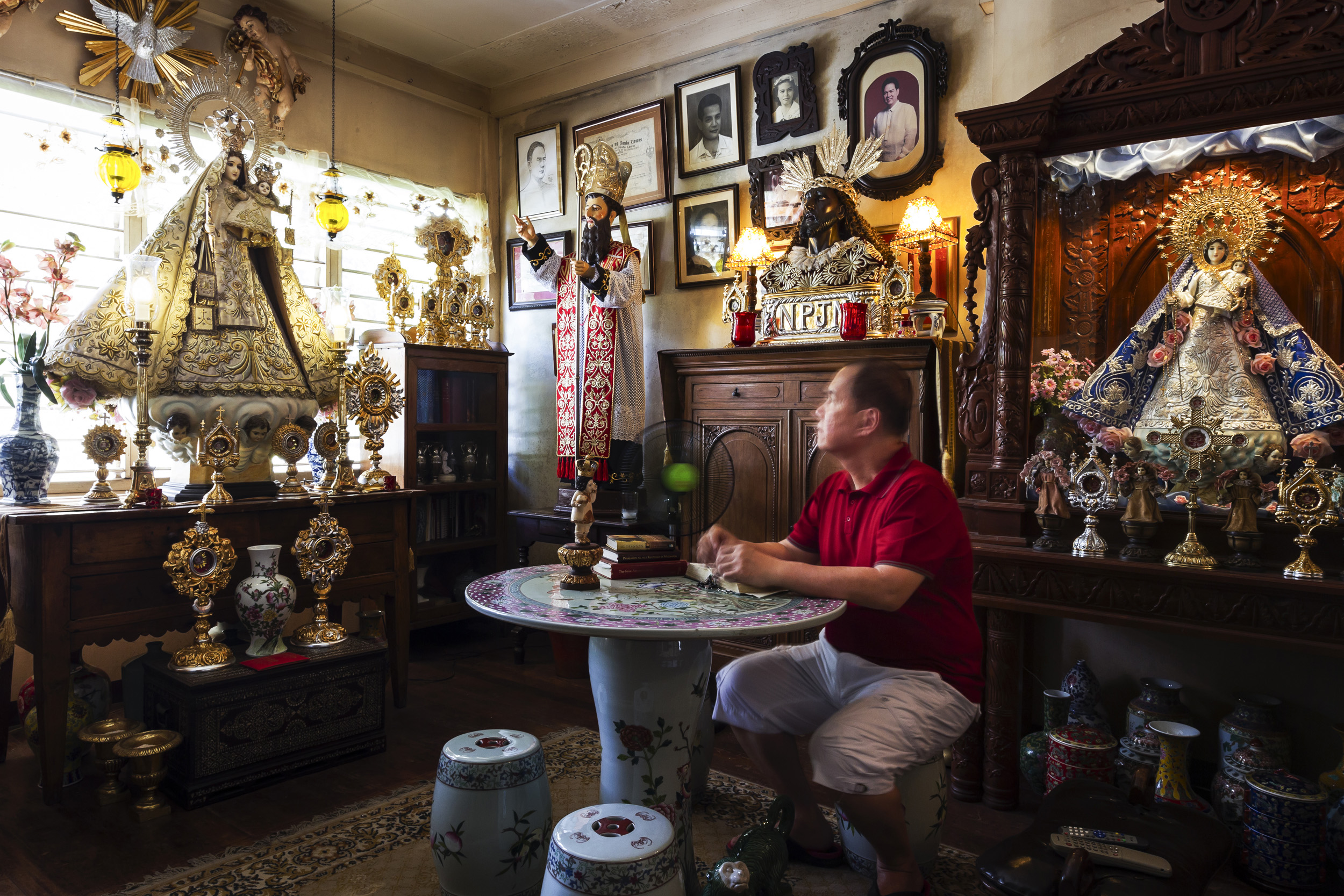
CEBU, PHILIPPINES, JANUARY 2012: A wealthy, devout Filipino man reads his bible study and cleans his religious icon collection which is largely carved out of Ivory, Cebu, Philippines, January 19, 2012. This collection has both new and old pieces, some carved over a hundred years ago but most carved recently. The main piece in this picture was carved 5 years ago. This man has extensive connections to other collectors and talks openly about the ivory trade and the "environmentalists" who are interfering with his and their collecting habits. Many of the piece in his collection are large, and would have been carved from a single large tusk. There is a collective of wealthy collectors in the Philippines who both search out and commision new work, thus sustaining a trade which allows for the continuing and growing market for new ivory. This has an inevitable effect on threatened elephant populations worldwide, accelerating demand for a commodity which is growing in value. This feature is about representing a global picture through a new and unseen lens. It places an onus of responsibility on an influential religious and wealthy elite. It offers them the chance to acknowledge their influence for good in the face of accelerating losses that are non-recoverable. It furthermore allows them to do so in the name of a value system integral to their expoused beliefs. It simply requires a reversal of priorities, from one that places iconography above life, to one that places life about iconography. This preaches a new message of compassion for all life, all God’s life, and ultimately benefits the protagonists and allows them to emerge not only unscathed but reinvigorates their standing as leaders in the value system their religious sector expouses. (Photo by Brent Stirton/Reportage for National Geographic.)

CEBU, PHILIPPINES, JANUARY 2012: A wealthy, devout Filipino man reads his bible study and cleans his religious icon collection which is largely carved out of Ivory, Cebu, Philippines, January 19, 2012. This collection has both new and old pieces, some carved over a hundred years ago but most carved recently. The main piece in this picture was carved 5 years ago. This man has extensive connections to other collectors and talks openly about the ivory trade and the "environmentalists" who are interfering with his and their collecting habits. Many of the piece in his collection are large, and would have been carved from a single large tusk. There is a collective of wealthy collectors in the Philippines who both search out and commision new work, thus sustaining a trade which allows for the continuing and growing market for new ivory. This has an inevitable effect on threatened elephant populations worldwide, accelerating demand for a commodity which is growing in value. This feature is about representing a global picture through a new and unseen lens. It places an onus of responsibility on an influential religious and wealthy elite. It offers them the chance to acknowledge their influence for good in the face of accelerating losses that are non-recoverable. It furthermore allows them to do so in the name of a value system integral to their expoused beliefs. It simply requires a reversal of priorities, from one that places iconography above life, to one that places life about iconography. This preaches a new message of compassion for all life, all God’s life, and ultimately benefits the protagonists and allows them to emerge not only unscathed but reinvigorates their standing as leaders in the value system their religious sector expouses. (Photo by Brent Stirton/Reportage for National Geographic.)

CEBU, PHILIPPINES, JANUARY 2012: A wealthy, devout Filipino man reads his bible study and cleans his religious icon collection which is largely carved out of Ivory, Cebu, Philippines, January 19, 2012. This collection has both new and old pieces, some carved over a hundred years ago but most carved recently. The main piece in this picture was carved 5 years ago. This man has extensive connections to other collectors and talks openly about the ivory trade and the "environmentalists" who are interfering with his and their collecting habits. Many of the piece in his collection are large, and would have been carved from a single large tusk. There is a collective of wealthy collectors in the Philippines who both search out and commision new work, thus sustaining a trade which allows for the continuing and growing market for new ivory. This has an inevitable effect on threatened elephant populations worldwide, accelerating demand for a commodity which is growing in value. This feature is about representing a global picture through a new and unseen lens. It places an onus of responsibility on an influential religious and wealthy elite. It offers them the chance to acknowledge their influence for good in the face of accelerating losses that are non-recoverable. It furthermore allows them to do so in the name of a value system integral to their expoused beliefs. It simply requires a reversal of priorities, from one that places iconography above life, to one that places life about iconography. This preaches a new message of compassion for all life, all God’s life, and ultimately benefits the protagonists and allows them to emerge not only unscathed but reinvigorates their standing as leaders in the value system their religious sector expouses. (Photo by Brent Stirton/Reportage for National Geographic.)
